5 Reasons Why Your Cruise Control Stopped Working
- Updated: March 15, 2023
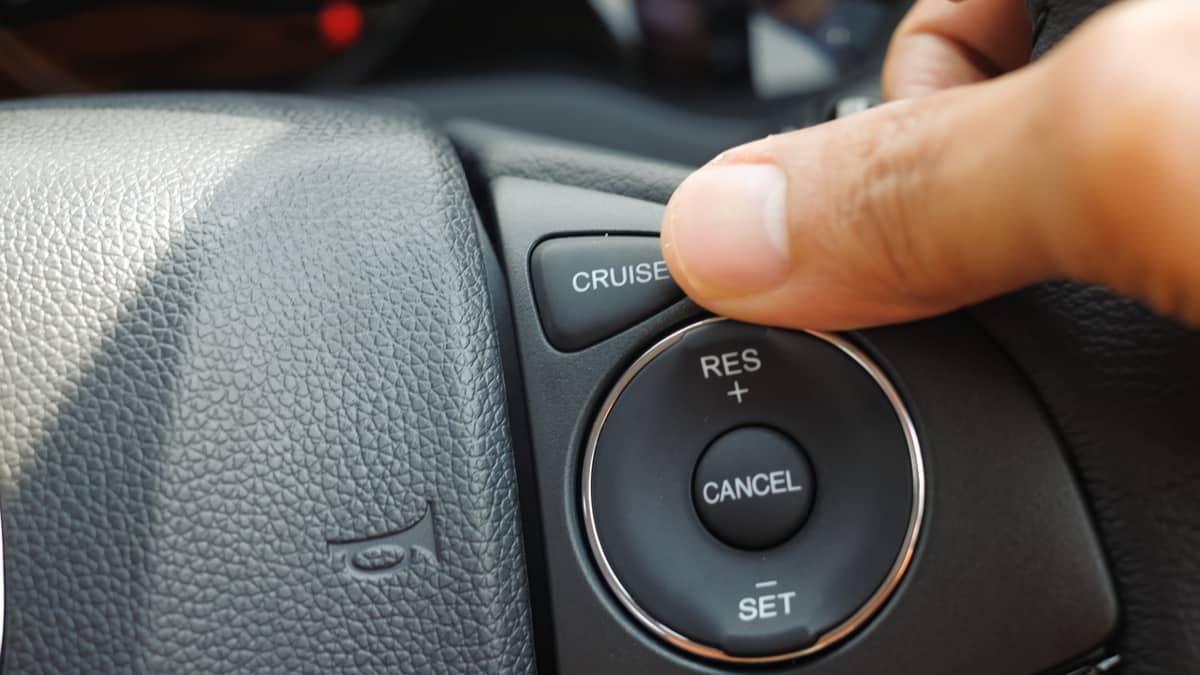
It would be difficult to find a vehicle on the road today without cruise control. This invaluable feature makes driving long distances easier but can also cause trouble when it malfunctions. Understanding the reasons your cruise control stopped working ensures that you can get the problem fixed quickly for a more enjoyable ride.
While this fault can cause issues with the cruise control system itself, there could also be an effect on the acceleration of your vehicle. That’s why you want to have it looked at as soon as you notice a problem. Let’s take a quick look at the reasons your cruise control may have stopped working.

Reasons Why Your Cruise Control Stopped Working
The most common reason a cruise control stops working is due to a blown fuse or a defective brake pedal switch . It can also be caused by issues with the throttle control system or the ABS. In older cruise control systems, it can be caused by a broken vacuum line.
Here is a more detailed list of the possible reasons your cruise control is not working:
1. Blown Fuse
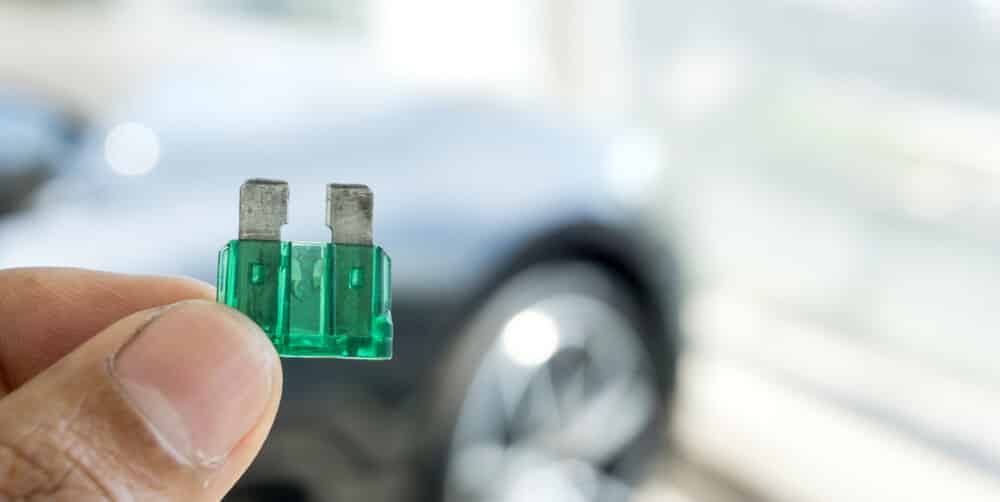
All electrical systems in the vehicle are controlled by fuses. Your cruise control system is attached to a fuse that can blow if there is a short circuit or fault. Without a good fuse, the cruise control system can’t work at all.
Thankfully, it’s not difficult to find and replace a blown fuse. Look in the owner’s manual to find the fuse that corresponds with the cruise control technology.
2. Defective Brake Pedal Switch
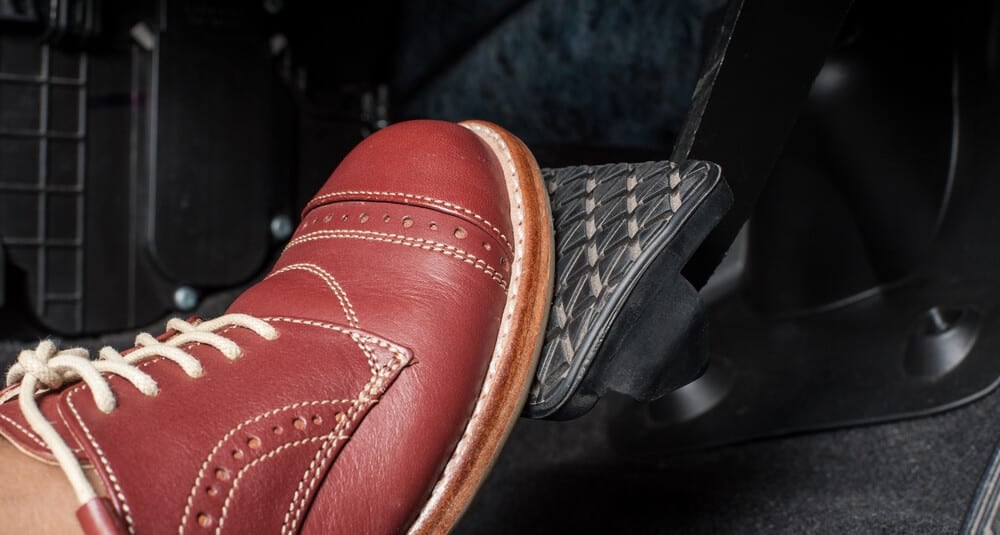
The brake pedal switch is responsible for turning the brake lights on and off based on the pedal position. Cruise control systems are designed to disengage whenever your brake pedal gets pressed.
Because the cruise control is wired into the brake pedal switch, any fault can cause it to stop working. When the brake pedal switch malfunctions, the car believes the brakes are engaged, causing the system to turn off automatically. Not only that, but your car’s brake light might also be stuck on, leaving confused drivers in your wake.
3. Malfunctioning Speed Sensor
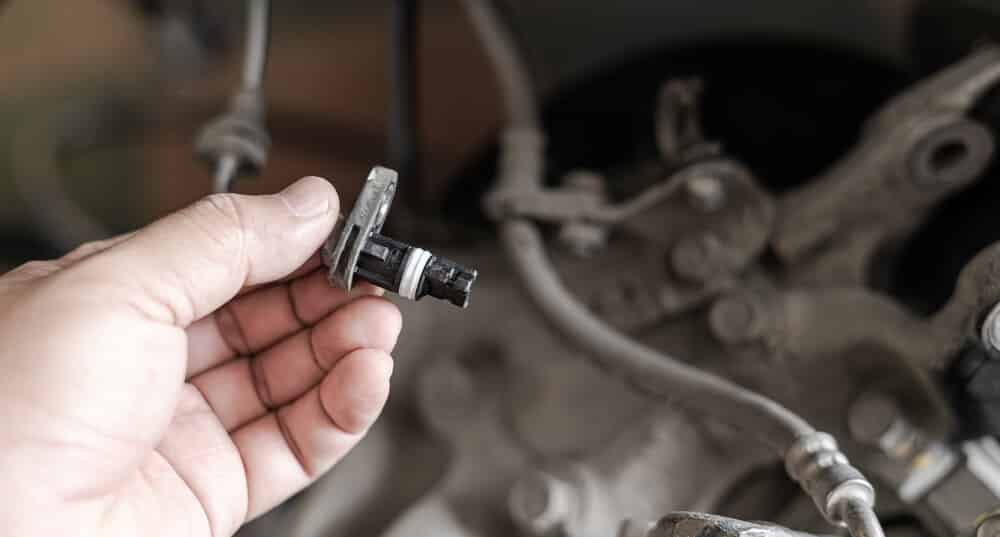
Speed sensors are located on every wheel or differential. The purpose of these sensors is to monitor the speed of the wheels to determine if traction control is needed.
The speed sensors are also part of the cruise control system. When a sensor fails, the cruise control can stop working and the speedometer might act strange as well.
If there is an issue with a speed sensor, it will often show with an ABS warning light or a check engine light on the dashboard.
RELATED: 3 Symptoms of a Bad ABS Wheel Speed Sensor
4. Electrical Issues
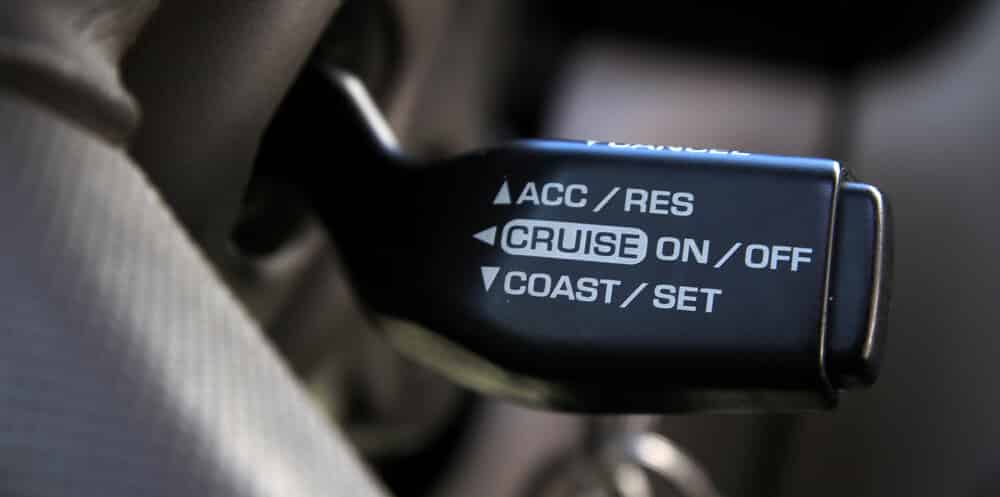
The cruise control system is electronic, with many components working together to make the system operate. If the cruise control fails to work, you want to check the wiring harness and associated connectors for a fault.
You also need to ensure that the voltage source is supplying enough power to the system. Even the smallest fault can cause defects with the cruise control. In many cases, there can be an issue with the cruise control lever or buttons causing the cruise control to not engage.
If your cruise control buttons are located on the steering wheel it could also be caused by a bad clock spring, which is located behind the steering wheel.
Check the system with an OBD2 scanner to look for any trouble codes related to the cruise control.
RELATED: 5 Symptoms of a Broken Clock Spring, Location & Replacement Cost
5. Damaged Vacuum Actuator, Hoses or Cable (Older cruise control)
If you drive an older vehicle with cruise control, you might have an issue with the vacuum actuator or the cable that connects to the throttle. If there has been damage done to the vacuum hoses or the actuator, the cruise control will stop working altogether.
Additionally, the cable linking the actuator to the throttle must be in good shape. If it has been broken, the cruise control will fail.
What is Cruise Control?
Cruise control is a feature that is used when you are traveling at a consistent speed. Cruise control was first introduced for automobiles in the 1950s. However, it took many years before it became a staple in the modern vehicle.
This electrical system allows you to set a predetermined speed and take your foot off of the gas pedal. If you are on a long drive, there is less fatigue because you don’t have to try to maintain your speed. Cruise control can also benefit fuel economy because the vehicle uses less fuel when traveling steadily.
In newer cars, you might be able to find adaptive cruise control , which is a smart technology. Adaptive cruise control allows you to travel at a predetermined speed, but it also helps to maintain a safe distance from the vehicles in front of you with the help of sensors. With conventional cruise control, you need to take over when the car in front of you slows down, but that’s not the case with adaptive cruise control.
There are also vehicles nowadays with not only cruise control, but fully self-driving vehicles . We will most likely see much more of this in the future.
Cruise Control Repair Cost
The cost to repair your cruise control system depends on what caused it to fail. If you need to replace a cruise control or brake switch, you might spend between $125 and $350, including parts and labor. However, the cost to change a fuse is only a few dollars and you can perform the replacement yourself in just a matter of seconds.
On the other hand, when something major fails, such as the actuator, you could be looking at a much higher repair bill. In some vehicles, the cost to replace a cruise control actuator can cost more than $700. These costs rise if you drive a luxury vehicle or one that is difficult to get parts for.
It might not seem immediately important for you to fix the broken cruise control, but this defective system can affect other performance aspects. You could start to notice issues with acceleration or have trouble with the speedometer. To play it safe, it’s always best to have the cruise control repaired as soon as you notice a problem.
Is there a fuse for the cruise control?
Yes. If the cruise control is installed from the factory, you should check your car’s owner’s manual for the fuse location. If it’s an aftermarket cruise control, you’ll need to follow the wires to find the fuse.
Does the brake switch affect the cruise control system?
Yes. The brake switch affects the cruise control system. The brake switch sends a signal to the cruise control system to let it know when the brakes are being applied for the engine to know when it should stop accelerating.
Will the cruise control work if the check engine light is on?
The cruise control function will be disabled when the check engine light is on in most car models, even if the cause of the check engine light is not the cruise control itself. This is mainly due to safety reasons.
Can a vacuum leak affect cruise control?
Older vehicles use vacuum to control the throttle for the cruise control, and in this case a vacuum leak can heavily affect the cruise control. However, modern cruise controls are fully electric and in most cases will not be affected by a vacuum leak if the check engine light is not illuminated.
Although many people may think that the cruise control system is unimportant and not worth spending money to repair, the problem can be caused by a faulty part that will affect the engine’s performance or durability. Therefore, it is best not to ignore the problem if your cruise control is not working without first diagnosing the car properly.
If your cruise control still isn’t working after trying all the tips in this article, it’s probably time to take it in for a professional opinion from a mechanic. It may be a more serious problem that requires replacement parts or repairs. In the meantime, drive safe and enjoy the open road!
Learn more:
- Brake Lights Not Working But Tail Lights Are? (How to Fix)
- Tail Lights Not Working But Brake Lights Are? (How to Fix)
- Brake Lights Stay On? (5 Causes & How to Fix it)
Categories: Electric , Troubleshooting
Related Posts
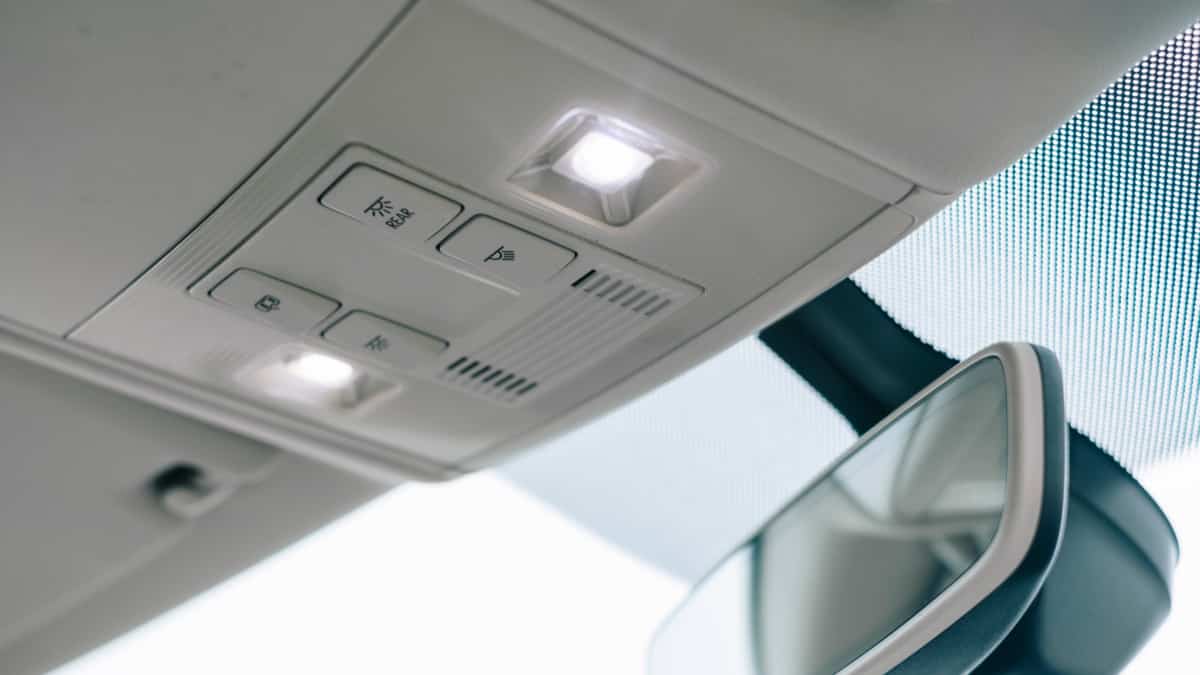
Latest Posts
- The Best & Worst Years Of Ford Explorer
- Best & Worst Years Of Toyota Corolla
- Best & Worst Years of Toyota RAV4
- When Should Your Child Switch To A Forward-Facing Car Seat?
- The Best & Worst Years Of Toyota Camry
- I Accidentally Put Premium Gas In My Car, What To Do?
- Why is my Cruise Control not Working? [14 reasons]
14 Reasons Why your Cruise Control may NOT Be Working
The reason for your cruise control not working could be as simple as a blown fuse to really complex electrical problems. Defective switches, sensors, and even “check engine” light, all could contribute to this problem.
If you like to travel and own a car fitted with cruise control, you know how comfortable it can be to maintain a constant speed! When a cruise control system gets damaged, it is just as annoying as it is dangerous.
Cruise control is connected to several components of the car, and when it fails it can mean that something could be wrong with the CC itself. It could also be a signal that something wrong is happening with any other component of the car.
Why is my cruise control not working?
In this article, I am going to show you the main reasons why your cruise control may not be working (from the simplest to the more complex ones):
Reason #1. Bad or blown fuse
The cruise control’s circuit (like many other electronic components of your car), is protected by a fuse that will blow to protect the system from short circuits and overloads. If your vehicle’s cruise control fuse is blown, the system will stop working.
You can replace the fuse with a new one of the correct amperage, according to your vehicle’s owner manual. If the new fuse doesn’t blow again, everything will be ok; if the fuse blows again, you have to keep searching for what is making that fuse blow.
Reason #2. Burnt brake lamp
Some cruise control systems are disabled when the brake lamp is blown. Check your brake lights. If you find a burnt brake light, just replace it and test the system again.
Reason #3. Defective brake light switch
A defective pedal switch can also make your cruise control stop working. Remember that all cruise control systems are automatically disengaged as soon as the brake pedal is pressed down.
If the cruise control didn’t stop working when a fault in the brake light or brake pedal switch is detected, it could be dangerous; that’s why the CC control unit constantly monitors the status of this switch.
Reason #4. Clutch pedal switch deactivation (for manual transmission vehicles)
Cruise control is deactivated when the clutch is pressed by the driver in manual transmission cars. The CC control unit monitors this switch as it does the brake light switch.
Reason #5. The vehicle speed sensor is not working
A vehicle’s cruise control needs to be able to determine the vehicle’s actual speed. This enables the system to determine how much throttle needs to be applied in order to keep a certain speed, among other things.
The speedometer speed sensor is not always the sensor used by cruise control. Some systems rely on the ABS speed sensors, others do an average and some have a dedicated speed sensor.
If the system can’t detect the vehicle’s speed or detects a problem with the speed sensor, it will stop working.
Reason #6. Faulty throttle body or accelerator pedal
In modern engines, the throttle body is driven electronically by the engine control unit (ECU), and the accelerator pedal works like a potentiometer. The processor managing the cruise control system will act as the accelerator pedal, sending more or less voltage to the throttle body to open or close the throttle body’s butterfly valve.
If there is a problem with your vehicle’s throttle body, your cruise control won’t work.
Reason #7. Check Engine light is “ON”
If your vehicle instrument panel has the “Check Engine Light” ON and the fault stored in the ECU’s memory is related to some component vital for the cruise control system, you will not be able to use your cruise control until you have fixed that problem.
Reason #8. Faulty steering wheel’s spiral cable/clock spring
The spiral cable connects all the switches from the steering wheel (in case your steering wheel has switches) to their respective modules. This includes the connection of the driver’s airbag.
These wires (also called clock springs) are prone to get cut. A faulty spiral cable may have an open circuit making it unable to reach the vehicle’s cruise control module (CCM).
Reason #9. Bad Cruise Control Switch
Your vehicle’s cruise control switches have internal contacts that wear out. If that happens, the switches won’t be able to contact the CCM.
Depending on which buttons are faulty, your whole cruise control can stop working or just some functions won’t work.
Reason #10. Electrical problems with different modules and wiring
Modern cruise control systems use electrical and electronic components, and they are connected to other modules and systems of the vehicle. Some of these systems are the ECU, ABS, and/or Stability Control Systems like ESP.
The CCM makes a check of these systems once the key is switched to ON, and if some of these components are not working in optimal conditions, the CCM won’t engage. If none of the above items seem to be the problem, the vehicle needs to be taken to a professional who can perform a full scan of all the components, check that all the voltages, wiring harnesses, and connectors are ok.
The professional is going to detect if there are any connection problems between modules and will be able to find the reason why the cruise control is not working.
Reason #11. Dirty or faulty camera or sensor (only for vehicles fitted with adaptive cruise controls)
Newer vehicles have adaptive cruise control systems. These devices not only keep a fixed speed by the driver; they also can detect other vehicles ahead and behind and are able to keep a safe fixed distance to avoid collisions.
Some of these new systems have laser sensors while others have cameras to calculate the right distance to follow considering the vehicle’s speed and acceleration. Any problem with the sensors will prevent adaptive cruise control from working.
Problems with older cruise control systems
Before electronic injection and electronic throttle bodies, some cars had the cruise control function. In fact, the first cruise controls were introduced in the early 1950s.
These electromechanical cruise controls are pretty simple. They have a vacuum actuator connected to the throttle linkage that opens and closes the throttle to maintain the vehicle’s speed.
In early injection cars, the throttle linkage was replaced by a cable. Some common faults of these old cruise control systems are:
- A faulty vacuum actuator. Vacuum actuators have a diaphragm inside that can break. Any vacuum leak will lead to failure.
- Faulty vacuum control solenoid. It can prevent the actuator from operating normally.
- Broken throttle cable. If the throttle cable or linkage is broken, it needs to be replaced.
I hope you enjoyed my guide to cruise control problems. Even though it doesn’t explain how to fix your cruise control, it gives you an idea of where to start looking if you are going to do it yourself.
Now you will have an idea about how the system works and what are the possible reasons why it’s failing (in case you have to take your vehicle to a shop to be repaired).
Attention! This article is for informational purposes ONLY and is NOT a replacement for professional advice! ALWAYS consult your local specialist for an appropriate solution to your problem. All statements, prices, contact information, recommendations, and reviews contained herein came from sources that we believe to be reliable, but the accuracy or completeness thereof is not guaranteed. Please contact the service provider for complete details and updates.
I always Know and admit that even though I went to school for ABR grad. In 1994 3.36gpa still have go go back to school for upgrades due to vehicle advancement but I still learned alot although I am dealing with an 05 f150 stx which has more recalls then a auto parts store where the employees don’t know a inerta. Switch from an ignition switch ,thanks for the information
Leave a Reply Cancel reply
Your email address will not be published. Required fields are marked *
Save my name, email, and website in this browser for the next time I comment.
Privacy Overview
Automated page speed optimizations for fast site performance

7 Reasons Why Cruise Control is Not Working
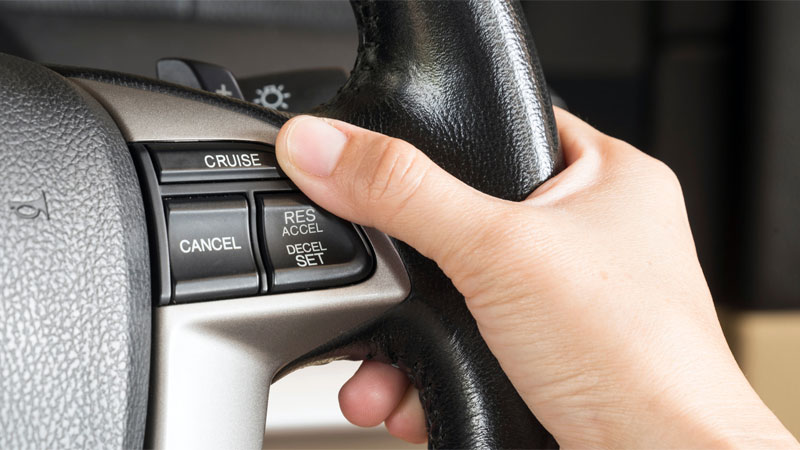
Cruise control has been around since the late 1950s. There was a time when you could only find this convenient feature in a few model vehicles. Nowadays, it seems like virtually every model vehicle on the road has a cruise control feature.
Cruise control not engaging seems like a trivial issue, but the inability to activate this convenient feature can certainly dampen any road trip. While cruise control failures “rarely” pose safety risks, determining the root cause is necessary to restore its use. Let’s look at the common causes of cruise control malfunction.
Table of Contents
Cruise Control Problems (Accelerating or Maintaining Speed)
If your cruise control feature malfunctions and stops working altogether, you may not think it’s an immediate concern. You’ll probably figure that you just can’t use cruise control anymore until you get the problem fixed.
However, the problem with your cruise control might be related to an acceleration issue too. In fact, there are components of cruise control which can have an adverse effect on the acceleration if those components are bad. That is why you need to be aware of what causes cruise control issues.
Common Causes of Cruise Control Not Working
There are several possible causes of cruise control not working. Below are the top 6 most common causes. Check each of these areas and see if they’re the cause of your cruise control issue. In many cases, the remedy to the problem is not that complicated or expensive.
1) Cruise Control Switch

The cruise control switch is what you use to set your cruising speed. This information is transmitted to the engine control unit and cruise control module in order to sustain the acceleration speed.
If the contacts inside the cruise control switch were to wear out, then the module and unit might not receive the necessary speed information it needs to keep the acceleration going. In response, the system will deactivate entirely and cancel the current cruise acceleration set.
2) Brake Light Switch
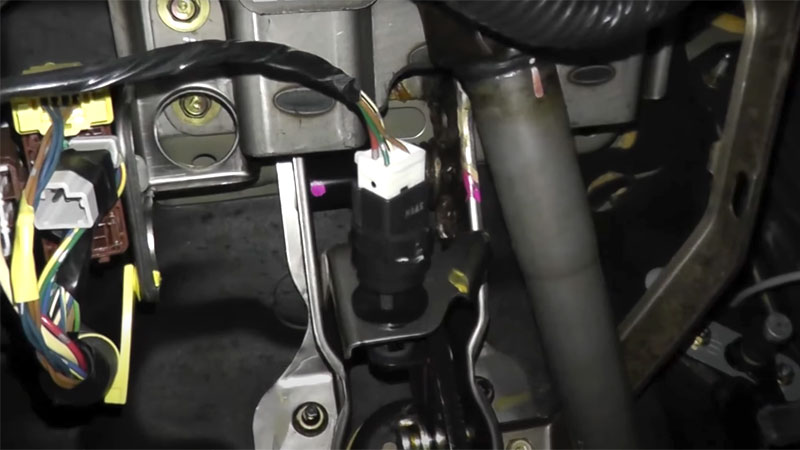
Normally, you press the brake pedal to turn off cruise control. The brake light switch must be detected by the cruise control system for this to happen.
If it cannot detect the switch, then cruise control will disable itself automatically until the brake light switch issue is fixed.
A faulty brake light switch can also cause your brake lights to stay on .
3) Blown Fuse
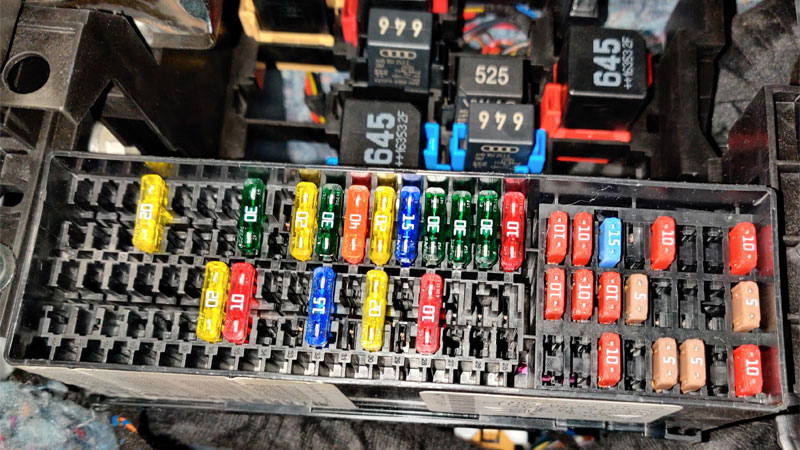
The electrical components of the cruise control system are protected by fuses. Like inside your house, it is possible to blow a fuse. This will cause the cruise control system to turn off until the fuse is replaced.
4) Check Engine Warning Light
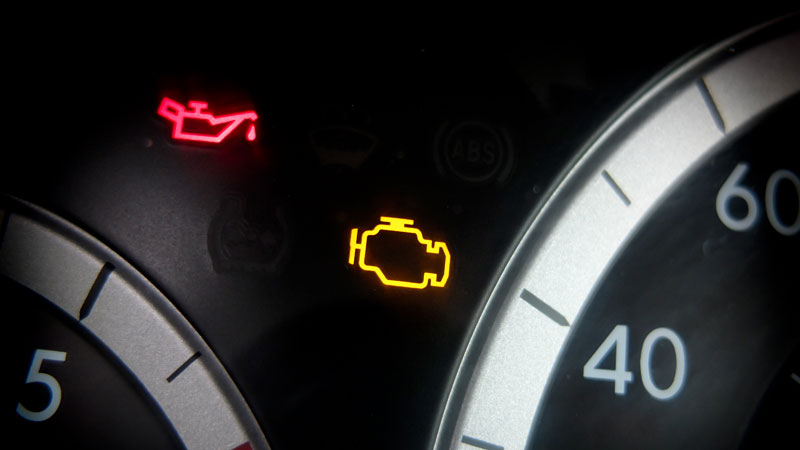
If the check engine warning light comes on, it usually means there is a problem with your transmission or engine. Once the engine control unit detects this problem, it may disable your cruise control system in response as a safety precaution.
Until you fix the engine issue, the cruise control will stay disabled.
5) Vehicle Speed Sensor
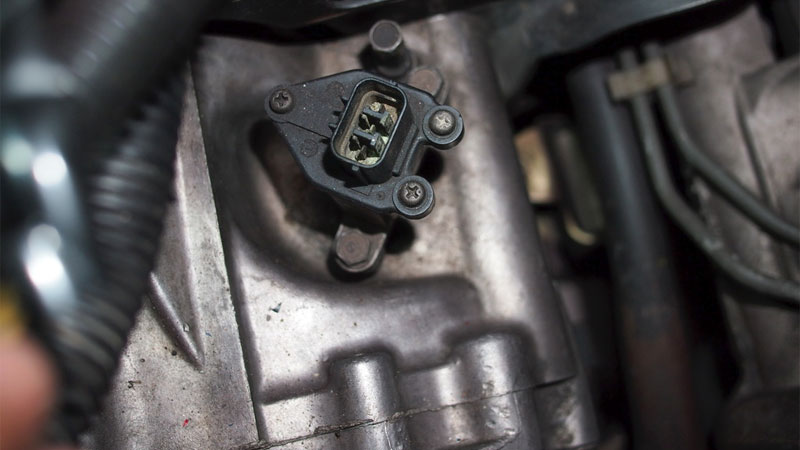
Most vehicles have a few vehicle speed sensors to transmit speed information about the vehicle to the engine control unit and the cruise control module. The only way your cruise control module is going to know how fast the vehicle is moving is if the vehicle speed sensors feed this information to it.
If the module cannot detect the speed because of faulty speed sensors, then the cruise control system will automatically deactivate.
6) Electrical Issues
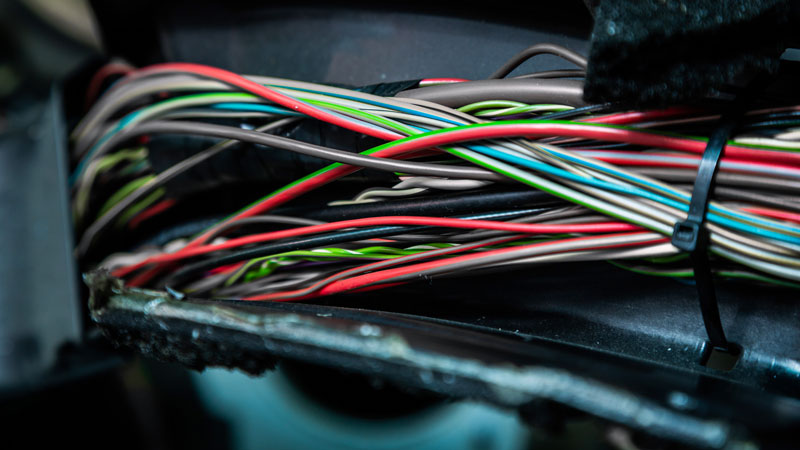
There are several electrical components connected to the cruise control system. The connectors and wiring harnesses, and ground straps are definitely components that you need to check when the cruise control stops working.
Make sure the source of the voltage is still supplying power to the system as well. If any of these components are loose or damaged, then it would explain why the cruise control isn’t functioning.
7) Loose or Broken Cruise Control Cable
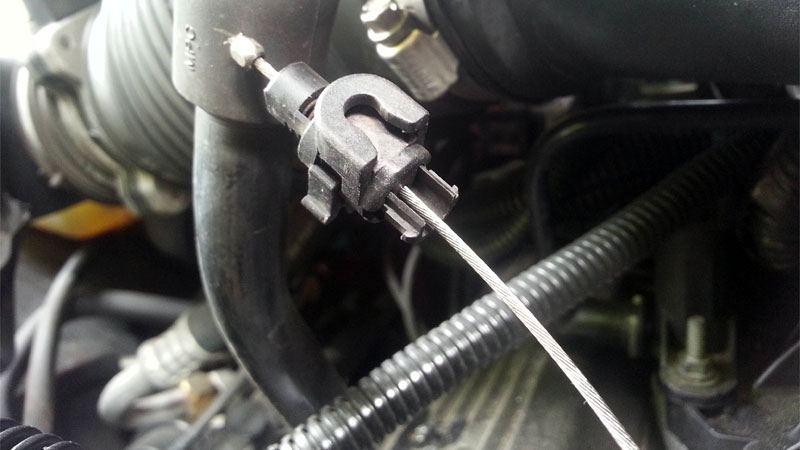
Older vehicles that are equipped with cruise control have two throttle cables – one for the gas pedal and one for the cruise control system.
These cables may stretch over time. If the cruise control cable has stretched or is broken, the cruise control system will not be able to operate the throttle plate properly.
Adaptive Cruise Control Specific Problems

Adaptive cruise control gives an extra layer of convenience while driving, as it adjusts your vehicle’s speed based on the distance to the car in front of you. However, this presents additional causes of cruise control failure.
One issue you might face is obstructed sensors. Both radar and cameras are important components of the adaptive cruise control system. When there’s dirt, debris, or ice covering these sensors, your cruise control can stop functioning. To prevent this, regularly clean your vehicle’s sensors, making sure they’re unobstructed.
Separately, failed cameras can also be a culprit. If the cameras aren’t working correctly, you may see an error warning. It’s best to get this checked by a professional to determine whether the cameras need repair or replacement. Hopefully it’s not as they are an expensive replacement.
Apart from cameras, adaptive cruise control relies heavily on radar technology for proper functioning. A misaligned or malfunctioning radar sensor can cause your system to behave irregularly. Again, consult a qualified technician to diagnose the issue and, if needed, recalibrate or replace the radar system.
Safe Driving Without Cruise Control
When cruise control systems fail, it presents challenges adjusting to speed management without the consistent pacing it provides. But there are a few things you can do.
- Focus on scanning gauges more frequently to stay actively aware of mph.
- Avoid zoning out on long hauls.
- Set phone alerts every few miles to remind checking current travel speed.
- Know highway speed limits well so mentally benchmarking against them continues subconsciously.
- Take frequent breaks stretching legs to re-energize alertness until able to diagnose cruise faults.
- Consider alternative adaptive cruise technologies equipped on newer vehicles if financially viable, providing automated incremental slowing when closing distances on lead cars.
- Remain vigilant of lead car distances and your own speed fluctuations.
- Utilize open lanes with fewer surrounding vehicles if possible, reducing needs for continual minor adjustments.
- Stay alert with renewed attention and defensive awareness absent cruise controls automated convenience until repairs are completed.
Intermittent Fault Identification
When cruise controls experience occasional yet repeating failures, meticulously logging every instance of malfunction helps uncover patterns guiding toward root causes.
Date and time each cutoff or disengagement that happens while activated. Detail any environmental or operational conditions present such as: weather, bumpy vs smooth roads, stop & go traffic versus highway speeds.
Reviewing complete repair histories alongside these event logs indicates if previously replaced components only provided temporary fixes before subsequent re-failure later on. Share documented patterns of when and how interruptions occur with shop technicians to guide their pathway tracing and component testing.
The goal is determining if specific elements like an old switch, wire insulation or solder joint chronically breaks down only under certain temperature, vibration or usage strain thresholds.
Cruise Control Repair Costs
So, your cruise control decided to take a break, and now you’re wondering how much it’ll cost to fix it. Well, repair costs vary depending on the specific issue and your vehicle’s make and model. This section will provide you with an idea of what to expect in terms of expenses.
Let’s look at the common reasons for cruise control problems and their approximate price range for replacement or repair:
- Faulty Cruise Control Switch – $100 – $200. A bit more expensive than a brake light switch.
- Blown Fuse – $5 – $30. Quick and affordable to replace.
- Faulty Brake Light Switch – $50 – $150. Can be a bit pricier but still manageable.
- Defective Speed Sensor – $100 – $300. Falls somewhere in the middle of the price spectrum.
- Throttle Control System Issues – $200 – $600. More expensive to diagnose and fix.
- ABS-related Problems – $200 – $1,000. Can also be quite costly to repair.
- Broken Vacuum Line – $50 – $150. Applicable to older systems and typically inexpensive to fix.
How Does Cruise Control Work?
If you normally drive long distances, especially on the interstate, then cruise control lets you take your foot off the gas while the car maintains the same speed, giving your leg a rest. This may seem like merely a luxurious feature rather than a necessity, but many people depend on it for safe driving.
There are several different types of cruise control systems, but all implementations share similar basic components. There is a sensor to measure vehicle speed, a throttle position sensor , and some mechanism to control the throttle plate without the use of the gas pedal.
Outputs from the speed and throttle position sensors allow the engine computer to determine how much the throttle plate needs to open or close to maintain speed.
Cruise control systems may also use sensors in the transmission, taking the current gear and engine vacuum into account. Throttle position will be different in each gear at a given speed, especially when driving over hills.
Related: How Does Drive-By-Wire Technology Work?
- Recent Posts
- Power Windows Not Working? (10 Common Causes and How to Fix) - February 8, 2024
- 14 Causes of a Car Losing Power When Accelerating - January 23, 2024
- 13 Causes of Poor Gas Mileage (Increase Your MPG) - December 13, 2023
13 thoughts on “7 Reasons Why Cruise Control is Not Working”
have a 2006 VW new Beetle my cruise works fine until i go to pass some one ,any idea what would cause it to do this? ?
When you hit the gas pedal to overtake, you might be disengaging cruise control.
i’ve heard that bad fuel can create such issue. As stated above, the Check Engine light will come on as part of the safety features to inform you something is not right. Cruise control picks up on this and shuts down.
The engine light was flashing then it stopped then started again, the cruise control is disabled but did come on a couple of times but went off when the engine needed to accelerate, the engine shakes when I. Accelerate too.
my aftermarket cruise on a 2013 Kio Rio LX wont light up
You’re going to have a hard time with finding help for that without providing the name and model of the aftermarket system. It might be best to take it to someone so they can troubleshoot in person.
My cruise indicator light will turn on but when I try to set the speed the light will shut off and not turn back on until I restart the engine. Any ideas what it might be?
Did you ever figure this one out. I got 99 Durango does this too
Cruise control goes rite into high speed when turned on,what could the problem be?
This helped me a lot. I got more out of your 6 reasons a cruise control may not work, than when I inquired about the same situation and got nothing. Thank You, Janet M.
Thanks for the feedback, Janet!
Helpful. Thank you
Mine is a mercedes benz c180, 2002 model my cruise control have just stopped working . So what are the possible causes
Leave a Comment Cancel reply

CarParts.com will be back soon!
We apologize for the inconvenience. The CP Team is working on some upgrades to improve our service. Thank you for using CarParts.com!
You can call us at
1-866-529-0412
Reference ID: 18.7fc733e.1714249438.109bb9e5
Car advice put simply.
Cruise control not working — causes and fixes
Troubleshoot and fix non-functioning cruise control in your vehicle..
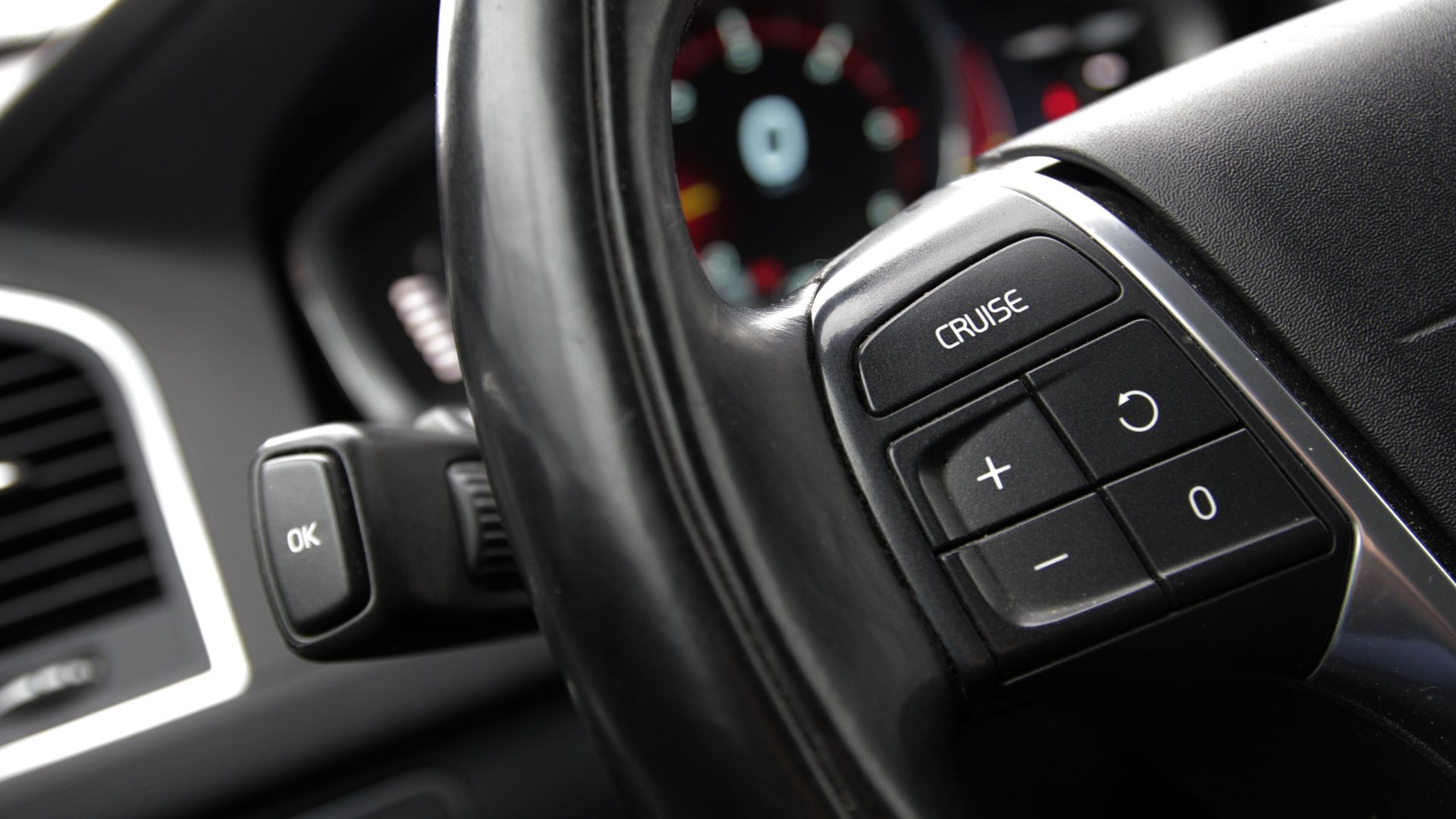
Cruise control is one of the most useful modern driving features which makes every longer journey easier. It lets you travel at a constant speed and reduces the pressure on your foot caused by frequent gas pedal pressing.
However, in case of the cruise control not working , it’s important to deal with the problem right away. If you turn the system on while it malfunctions, you might not be able to turn it off during the drive. So, you can follow this guide to get all the information about the most common reasons for failing cruise control and get advice on how to fix it.
What’s cruise control and how does it work?
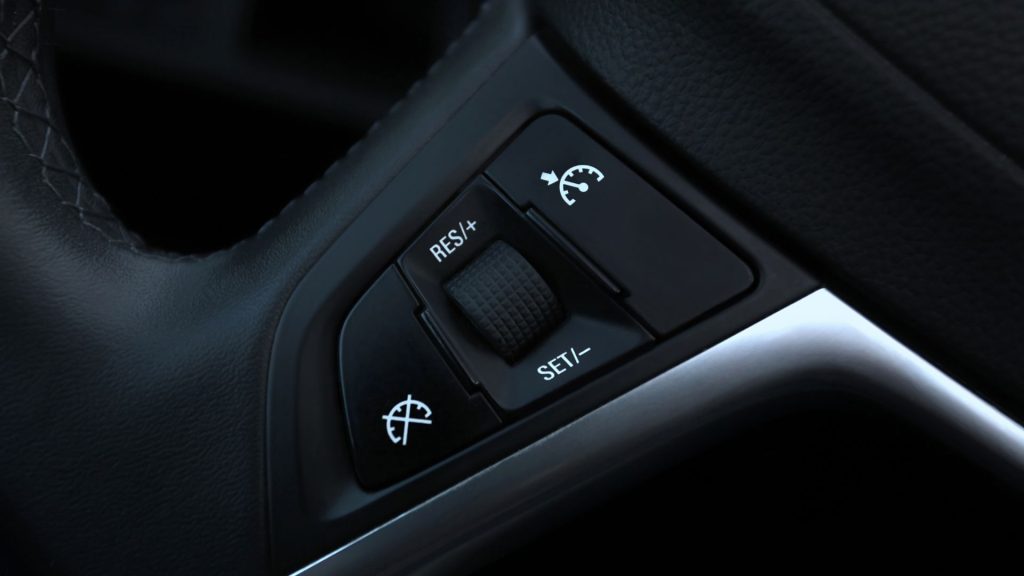
To get a better understanding of possible reasons behind malfunctioning cruise control, it’s time to deal with the basics behind the system. Cruise control is an electronic system that helps you maintain a certain speed level for extended periods without holding your foot on the gas pedal.
While driving regularly, the pressure with which you push the gas pedal is transmitted to the throttle position sensor which controls the throttle valve. If you press the pedal further down, the valve gets open, and more air flows into the engine.
On the other hand, if you apply less pressure, the valve is nearly closed, slightly letting air in. The engine control unit (ECU) uses these measurements to calculate fuel injection and translate the pressure into driving power and speed.
The modern cruise control system controls the throttle position sensor and other sensors and electronically simulates the pressure on the gas pedal. Even some older vehicles have cruise control, but in these cars, cruise control used a cable that physically maintained pressure on the accelerator.
With modern improvements, there’s also the introduction of adaptive cruise control which uses several drive assist systems to maintain your speed. These include lane assist and the possibility to increase and lower the speed by pressing the button.
Modern cruise control also measures the speed of the car in front of you in the lane to maintain a safe distance. If you are a car guy, you probably enjoy having control over the machine yourself. However, cruise control is extremely useful during a long highway ride, since it reduces the fatigue and pain of pressing hte4 accelerator for hours.
Reasons behind cruise control not working
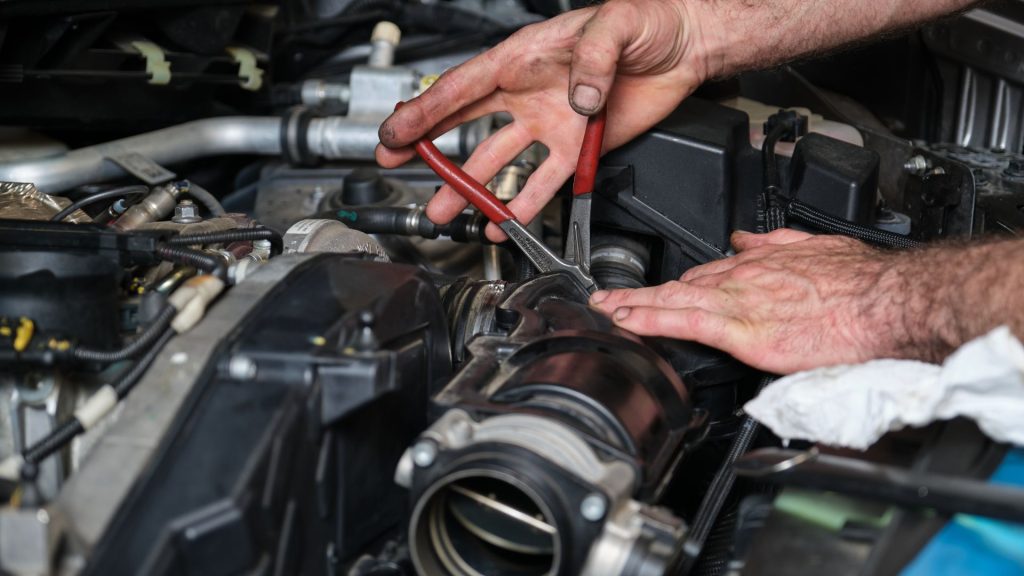
Now that you know how the cruise control system works, it’s time to dig deep into the possible reasons behind its malfunction. First, we come by electrical issues since this is an electrical feature after all. However, there are also other possible reasons, so let’s take a look at a few of the most common ones:
- Problems with the throttle body
- Malfunctioning sensors
- Blown fuse and electrical issues
- Faulty brake pedal switch
- Bad mechanical cruise control cable
All of these reasons can make your cruise control ineffective and the worst thing is if it malfunctions while you are using it. It’s also a bad thing since cruise control saves gas while on long journeys down the highway, so you’ll want to fix the problem based on the listed reasons as soon as possible.
How do throttle body issues affect cruise control?
In case the throttle body valve gets stuck, or the throttle body gets clogged, you’ll have a hard time using your cruise control system. The worst thing that could happen in this case is if the gas pedal gets stuck in position, which also affects your driving regardless of the cruise control.
You can clean your throttle body with specific products to be able to use cruise control again and to ensure proper air intake into your engine. Modern cruise control systems lock the throttle valve in a position to ensure even air intake, so if the valve malfunctions, you won’t be able to use it.
Bad or malfunctioning sensors
As mentioned, cruise control is an electrical system and it uses the readings of multiple sensors to adjust and maintain your driving speed. Out of these sensors, the throttle position sensor and the speed sensor are most relevant for the system’s operation.
We already mentioned how the throttle position sensor affects the control of the throttle valve, and the speed sensor monitors the driving speed. It sends information to the ECU regarding the traction control system by the speed readings. If the sensor fails, you’ll likely experience some strange speedometer action and an anti-lock braking system ( ABS ) warning light on the dashboard .
So, the cruise control system might also fail, as it uses the readings of these sensors as well as the data of the ECU regarding traction control and ABS usage.
Blown fuse or electrical issues
One of the easiest fixes for a bad cruise control system is to just replace a blown fuse. If this happens, you can just take a look at the fuse box by referring to the owner’s manual of your vehicle for the exact location. Usually, there’s a fuse box under the hood or just the left of the steering wheel in the car’s interior.
If there’s a circuit short, the fuse might blow, and simply replacing it will bring the system back on again. Also, other electrical issues can occur such as a bad connection with the control buttons on the steering wheel or electrical connections
Bad brake pedal switch
The cruise control system in your car is connected to the brake pedal switch. It’s the switch that communicates with your tail lights and turns them on as you press the brake pedal. If the switch goes bad, the signal gets interrupted, and it can reflect on your cruise control system as well.
Most cruise control systems are designed to disengage as you press the brake. So, if the computer believes the brakes are pressed due to a faulty switch, it will turn off the cruise control system.
Worn mechanical cable for older cruise control systems
As mentioned, old cars with cruise control often use a cable that locks the accelerator in place as you activate the system. This ensures that the accelerator pressure stays the same during the time the system is active.
The mechanical system also uses an actuator and hoses, and these could all wear off due to frequent usage. So, if any of the mechanical components malfunction, you won’t be able to use the cruise control system.
Fixing a failed cruise control system
If your cruise control system works on some occasions, while it fails on others, don’t use it while driving. It’s not safe and the best thing you can do is inspect the system based on the reasons behind a malfunctioning cruise control.
You can do some repairs yourself, including testing and replacing a blown fuse. On the other hand, you’ll need the help of the mechanic to replace a bad actuator in mechanical systems or to fix the brake pedal switch.
Overall, if you spot your cruise control not working, you shouldn’t use it while driving until you make the repairs. Some systems will fail on some occasions, while you’ll sometimes be able to use them regularly. It’s still better to inspect the system based on the common reasons behind its failure listed in this guide and make proper repairs.
This way, you can save yourself some trouble, along with gas and effort while driving with the cruise control system active.
What could cause the cruise control to stop working?
A blown fuse or a faulty brake pedal switch could cause the cruise control to stop working, along with malfunctioning sensors.
How do I know if my cruise control fuse is blown?
You can know if your cruise control fuse is blown by taking a look at the fuse box, and you can find the fuse box location in the owner’s manual.
Where is the fuse for the cruise control?
The fuse for cruise control is located within the fuse box under the hood or at the left of the steering wheel.
How much money does it cost to fix cruise control?
It costs anywhere from $10 for a replacement fuse, to $500 for the actuator or the throttle body repair to fix the cruise control system.

Filip is a lifelong car enthusiast with over 3 years of experience writing about cars and had worked as a mechanic apprentice for over 5 years, gaining hands-on expertise in automotive mechanics. At REREV, he combines his passion for cars with his comprehensive knowledge to provide readers with a unique blend of technical insight and engaging storytelling that sets the bar high for automotive content.
- Editorial Guidelines
Car Insights
- Years to avoid
- Collections
Cruise Control Not Working? 9 Potential Causes
gabrieletamborrelli / Getty Images
- Cars & Motorcycles
- Frugal Living
- Fine Arts & Crafts
- Card Games & Gambling
- Playing Music
Cruise control reduces stress and fatigue on long drives, but if the system isn't working properly, it can become dangerous. If your vehicle's cruise control isn't working, one of the following nine issues may be the root cause.
How Cruise Control Works
Cruise control is a system to maintain vehicle speed without direct driver input. When you want to engage cruise control, you first turn the system “On” with a button or switch. However, this alone does not start the cruise control. When you “Set” cruising speed, the cruise control module (CCM) records the current speed, then takes control of the throttle body to maintain vehicle speed. When vehicle speed increases or decreases (due to wind or hills, for example), the CCM decreases or increases throttle body opening accordingly.
By modulating engine speed, the CCM can maintain your desired cruising speed on the highway. You can increase or decrease cruise speed by tapping a button or lever, and you can cancel cruise control by hitting the “Cancel” or “Off” buttons or stepping on the brake.
Throttle body control has changed over the years. Early systems used a vacuum motor and cable, but these eventually changed over to electric motors. Most recently, with the development of drive-by-wire or electronic throttle control systems (ETCS), cruise control is built into the engine control module (ECM), which controls the throttle body electronically.
Basic cruise control systems still require the driver to pay attention to changing road and traffic conditions. Adaptive cruise control systems, sometimes called "smart" cruise, use radar or laser detection to maintain safe distances from vehicles ahead. Some adaptive cruise control systems merely reduce engine speed to maintain distance, but some of the newest adaptive cruise control systems can also engage the brakes to slow or stop the vehicle. Still, even with adaptive cruise control, it's important that drivers never take their eyes off the road.
Why Is My Cruise Control Not Working?
There are a few basic ways that cruise control can fail, depending on how the system is designed. You may not be able to do much about ETCS cruise control systems, but there are a few things you can check:
Brake Light Switch – As cruise control is automatically cancelled by depressing the brake, some vehicles may disengage cruise control if it cannot detect the brake light switch.
Brake Lights – In some systems, cruise control is disabled when a brake light is blown. Aftermarket lighting, such as LED brake light conversion, might trick the CCM into thinking a brake light is blown, as LED bulbs draw less current than incandescent bulbs.
Fuses and Relays – On some vehicles, fuses and relays are used to protect the cruise control actuator circuit . If the fuse is blown or the relay is faulty, the system won’t work.
Spiral Cable – Many vehicles mount the cruise control switch on the steering wheel. A faulty spiral cable may have an open circuit, preventing the switch from contacting the CCM.
Control Switch – If the internal contacts wear out, the cruise control switch may not be able to contact the CCM. This might disable cruise control completely, or it might not react to the cancel or accelerate functions.
Check Engine Light – On some modern vehicles, particularly those equipped with ETCS, cruise control may be disabled if there is an engine or transmission problem .
Vacuum Leak – Some older vehicles used vacuum actuators to control the throttle body during cruise control operation. If there is a leak, such as a cracked hose or tube, the system won’t work. A vacuum leak might cause the engine to idler higher or set a fuel trim code.
Vehicle Speed Sensor – There are usually multiple vehicle speed sensors (VSS) on any given vehicle. The CCM might use a VSS feed from the ECM, instrument cluster, or transmission. If that signal is lost, the CCM can’t detect vehicle speed, disabling cruise control.
Electrical Problems – As most cruise control systems use electrical or electronic components, any diagnosis should include a thorough check of source voltage, wiring harnesses, and connectors. Anything loose or broken could disable the system entirely.
If your cruise control isn’t working properly, avoid using it until it is repaired. A faulty cruise control system may not cancel on demand, which will create a safety hazard for you and those around you. After assessing your cruise control yourself, take your vehicle to a trusted mechanic for a check or a couple diagnosis and repair.
- How Electronic Throttle Control (ETC) Works
- How the Air Intake System Works
- ABS Brakes and the Facts
- Engine Vacuum Leak: Symptoms and Solutions
- How to Find a Short Circuit
- Troubleshooting Common Condenser Fan Problems
- How to Diagnose a Ford Expedition Transmission Problem
- Why Is My Car Shaking at Idle?
- Diagnosing GM Converter Lock-Up Problems
- 3 Ways to Reset a Check Engine Light
- Car Charging System Check
- What Is a Throttle Body and How Does It Work?
- Why You Can't Read Your OBD-II Codes
- What to Do When Your Car Won't Start or Turn Over
- Why Does the Emergency Brake Light Stay on in My Chevy C1500 Pickup?
- What to Do When Your Tire Pressure Light Is Flashing
Why Is My Cruise Control Not Working? 6 Common Reasons
By: Author Zach Reed
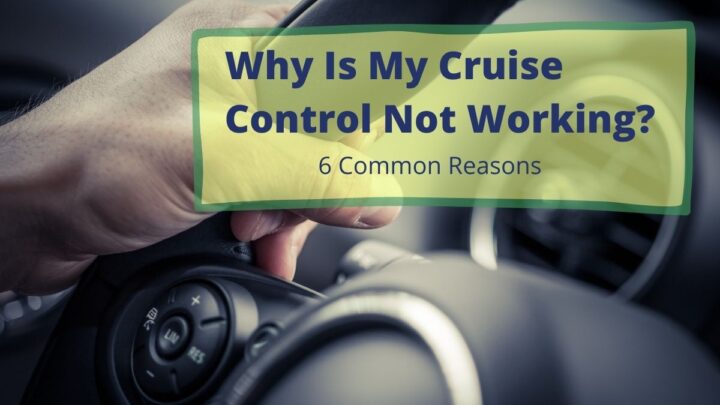
When your cruise control stops working, it can be quite an inconvenience. In this expert guide, we’ll talk about the most common reasons it can fail.
If you’re old enough, you can probably remember driving on road trips , or even just on your daily commute to work, before cruise control was a thing. It can be downright exhausting.
Unfortunately, even modern-day cars can have a failing cruise control system and it can seem like you’ve been thrown back into the stone ages.
Okay, that might be a bit dramatic, but it really can be annoying when cruise control stops working. But why does that happen?
The most common reasons that your cruise control might stop working include a bad cruise control switch, a blown fuse or relay, problems with the engine or transmission, a faulty vehicle speed sensor, a bad brake pedal switch, or a broken cruise control cable.
If your car’s cruise control isn’t working, it can be a major pain.
What do you do if your cruise control stops working? Here are some of the most common reasons why it might not be working, and how to fix it!
To fully understand why cruise control stops working on a car, we researched the most common reasons so that you know exactly what’s wrong with it.
Since we’ve already done the research for you, all you need to do is run through the list of common reasons below and you’ll be able to get your cruise control figured out in no time.
How Does Cruise Control Work?
Before we get into the reasons that cruise control might not be working in your car, it’s important that we first explain how the cruise control system works in the first place.
By understanding how cruise control works and what components are involved, you’ll have a much better understanding of why the issues below can prevent cruise control from working.
So, how does cruise control work?
The cruise control system in your car is made up of a few different parts. There’s a cruise control switch, which is usually located on the steering wheel, that turns the system on and off.
There are also fuses and relays that power the system, and a speed sensor that tells the system how fast the car is going. These sensors report back to the cruise control module, which controls a cruise control servo.
This servo is what actually controls the throttle of your car , and it’s what tells the car to speed up or slow down to maintain the cruise control speed.
Finally, there’s a brake pedal switch that tells the system when you’re braking and a cruise control cable that connects the accelerator pedal to the cruise control system.
All of these parts and pieces work together to enable your car to maintain a set speed without you having to constantly adjust the accelerator.
Now that we know how the cruise control system works, let’s take a look at some of the most common reasons why it might not be working in your car.
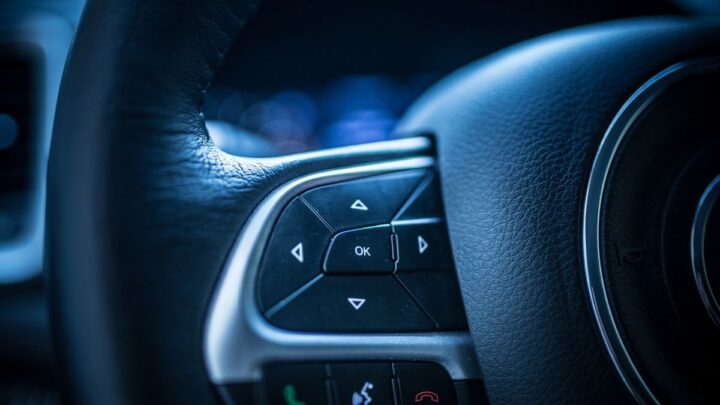
Most Common Reasons That Cruise Control Isn’t Working
1. bad cruise control switch.
One of the first things to check if your cruise control isn’t working is the switch. This is usually located on the steering wheel or stalk. If it’s a bad switch, then it might need to be replaced.
This is usually pretty easy to check because you can just try to turn the system on and see if it engages.
In most cars, a light will illuminate somewhere on your dash (or on the button itself) once you press the switch to turn on cruise control.
So if you hit the button or switch but you don’t see a light illuminate anywhere, it could be an indication that the button or switch itself is bad. But that’s not the only reason you might not see the light turn on.
2. Blown Fuse or Relay
Another pretty common reason that cruise control might not be working is because of a blown fuse or relay.
These are usually located in the fuse box under the hood. If you think this might be the case, then you can just check the fuse box to see if there’s a blown fuse or relay.
If you don’t see a blown fuse or relay, it could still be the problem. Sometimes the fuse or relay might not look blown but could still be bad.
In this case, you might need to use a multimeter to test the fuse or relay to see if it’s still good. Typically, a relay will audibly “click” when it’s activated, so if you don’t hear the clicking noise, the cruise control relay might be bad.
3. Engine or Transmission Problems (Check Engine Light)
If the cruise control system is engaged but the car doesn’t seem to be responding, it could be because of engine or transmission problems.
These types of problems can be pretty serious, so it’s definitely something you’ll want to get checked out by an experienced mechanic or technician. Often, this will be accompanied by your check engine light turning on.
Furthermore, sometimes the cruise control system won’t even engage if there are overarching issues with the engine or transmission that would prevent it from working.
This is more commonly seen in newer cars where the electronics and computer system are so advanced and integrated that it will prevent you from using cruise until you fix the underlying issues.
4. Faulty Vehicle Speed Sensor
One of the most common reasons that cruise control might not be working is because of a faulty vehicle speed sensor. This is the sensor that tells the cruise control system how fast you’re going.
If it’s not working correctly, then the cruise control system won’t be able to maintain the correct speed.
In most cases, a faulty speed sensor will need to be replaced. However, sometimes you can clean the sensor and fix the problem. This is usually pretty easy to do and you can find instructions online or in your car’s owner’s manual.
You usually have to jack your car up and remove the wheel to get to the sensor, so make sure you’re being careful and following the owner’s manual!
5. Bad Brake Pedal Switch
Another common reason for cruise control not working is a bad brake pedal switch. This switch is located on the brake pedal itself and tells the cruise control system when you’re pressing the brakes.
If it’s not working correctly, then the cruise control system won’t know when you’re trying to stop and it could cause some serious accidents .
In most cases, you’ll need to replace the switch if it’s not working correctly. However, if you’re lucky, you might be able to clean it and get it working again.
Sometimes it can even just come unplugged and all you need to do is plug it back in. Either way, this is a pretty easy fix that you should be able to do on your own.
6. Broken Cruise Control Cable
Last up on our list of the most common reasons cruise control might not be working is a broken cruise control cable. This is the cable that runs from the cruise control module to the throttle body.
If it’s broken, then the cruise control system won’t be able to tell how much gas to give the engine and it won’t work correctly.
The vast majority of the time, you need to replace the cruise control cable if it’s broken. However, sometimes it might have just come loose or come off the track at the throttle body and you just need to reattach it correctly.
This cable has to have the correct amount of tension in order to operate properly, so you might want to leave this one up to the professionals if you aren’t confident about it!
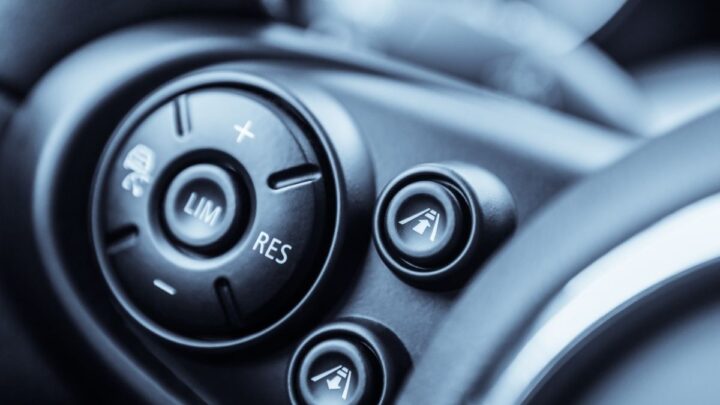
How Hard is it to Fix Cruise Control on Your Car?
Now that you know why your cruise control might not be working, you’re probably wondering if it’s something you can handle on your own. That really depends on what the problem is.
As you can see from the list above, some of the issues are pretty easy to fix, like a blown fuse or bad brake pedal switch, while others are pretty difficult, like engine or transmission problems.
If you’re having trouble with your cruise control, the best thing to do is take it to a qualified mechanic or technician and have them diagnose the problem.
They’ll be able to tell you exactly what’s wrong and how difficult (and expensive) it will be to fix. Most of the issues with cruise control are fairly simple and inexpensive, and the convenience of the feature usually makes the repair worth it!
Conclusion on Common Issues For Cruise Control
There are a few different reasons why cruise control might not be working in your car anymore, including a broken switch, a blown fuse or relay, or faulty speed sensors.
Whatever the problem may be, figuring it out is the first step so you can go back to cruising on the roads without a problem.
We hope this article helped shed some light on why cruise control might not be working in your car.
Be sure to take it to a professional if you’re having any trouble so they can help you get back on the road safely!
Hi, I'm the founder of VehicleAnswers.com! Having owned a wide variety of vehicles in my life, I was astounded at how hard it can be to find answers to common automotive questions. Rather than sit idly, I decided to create this website to help others!

Cruise Control Not Working? Troubleshoot It Now!
Are you experiencing issues with your cruise control? Don’t worry, we’ve got you covered! Cruise control is a convenient feature that allows you to maintain a constant speed without using the accelerator pedal. However, when it stops working, it can be frustrating and potentially dangerous. In this article, we’ll help you troubleshoot common cruise control problems and provide you with diagnostic tips to get you back on the road in no time.
Key Takeaways
- Understanding how cruise control works is crucial for troubleshooting.
- Common reasons for cruise control failure include faulty brake light switches, worn-out cruise control switches, and electrical problems .
- Ford vehicles may have specific cruise control issues, such as burned-out brake lights or faulty control switches .
- Troubleshooting tips include inspecting the brake light switch, checking for vacuum leaks, and diagnosing electrical problems .
- Fixing cruise control problems may involve replacing faulty components or seeking professional assistance.
How Does Cruise Control Work?
Cruise control systems work by utilizing a combination of components to maintain a set speed in your vehicle. Understanding how cruise control systems function is crucial for diagnosing and troubleshooting any potential issues.
When you activate the cruise control system by pressing the ‘on’ button, it enters into a standby mode, awaiting your instructions to set the desired cruising speed. Once you have reached the desired speed, you can set it by using the control buttons typically located on the steering wheel or stalk.
Now, let’s delve into the inner workings of a cruise control system. Once the cruising speed is set, the cruise control module takes control of the throttle body , which regulates the amount of air entering the engine. By adjusting the throttle body opening, the system maintains the desired speed, compensating for changes in incline and external factors.
During operation, various sensors constantly monitor the vehicle’s speed, throttle position, and other relevant parameters. These sensors provide continuous inputs to the cruise control module, which in turn adjusts the throttle body opening accordingly to maintain the desired speed.
If you need to cancel the cruise control function, you can do so by pressing the ‘cancel’ or ‘off’ button or applying the brakes. These actions deactivate the cruise control module, allowing you to regain control of the throttle and return to normal driving mode.
It’s important to note that cruise control systems are not fully autonomous. They assist the driver in maintaining a constant speed but still require attentive driving and awareness of the road conditions. Cruise control should never be used as a substitute for actively monitoring the road ahead and reacting to unexpected situations.
Now that we have a basic understanding of how cruise control works, let’s explore some common reasons for cruise control failure and learn how to troubleshoot these issues.
Common Reasons for Cruise Control Failure
If your cruise control is not functioning properly, there could be various reasons behind its failure. Understanding these common issues will help you troubleshoot and resolve the problem.
1. Faulty Brake Light Switch
A faulty brake light switch is a common culprit for cruise control failure. When the brake light switch is malfunctioning, it can prevent the cruise control system from engaging or disengaging correctly.
2. Worn-Out Cruise Control Switch Function
Over time, the cruise control switch function can wear out, resulting in the inability to set or maintain the desired cruising speed.
3. Brake Light Issues
Brake light issues , such as a burned-out bulb or wiring problems, can interfere with the proper functioning of the cruise control system.
4. Spiral Cable Fault
A faulty spiral cable, which is responsible for transmitting electrical signals between the steering wheel and the rest of the vehicle, can cause cruise control failure.
5. Check Engine Light
If the check engine light is illuminated, it may indicate underlying issues with the vehicle’s engine or emissions control system, which can affect the cruise control functionality.
6. Blown Fuses and Damaged Relays
Blown fuses or damaged relays in the cruise control circuit can disrupt the flow of electrical power, leading to cruise control failure.

7. Vacuum Leak
A vacuum leak in the engine can cause a loss of vacuum pressure, affecting the cruise control system’s ability to maintain the set speed.
8. Vehicle Speed Sensor Fault
A malfunctioning vehicle speed sensor can prevent the accurate transmission of speed information to the cruise control module, resulting in functionality issues.
9. ABS Sensor Faults
Issues with the anti-lock braking system (ABS) sensors can affect the cruise control system, as these sensors provide essential data for maintaining speed and stability.
10. Electrical Problems
Electrical problems , such as wiring issues, faulty connectors, or a malfunctioning cruise control module, can disrupt the proper functioning of the cruise control system.
Identifying and addressing these common reasons for cruise control failure can help you troubleshoot and resolve any issues you may be experiencing. By addressing these problems, you can ensure the smooth operation of your cruise control system and enjoy a comfortable driving experience.
Ford Cruise Control Not Working?
If you own a Ford vehicle and are experiencing issues with your cruise control, you’re not alone. Ford cruise control can sometimes fail to work altogether or operate intermittently. To help you troubleshoot and resolve these problems, we’ve identified some common issues that may be affecting your Ford’s cruise control system.
Common Issues with Ford Cruise Control
There are several common issues that can cause Ford cruise control to malfunction. These include:
- Burned out brake lights
- Blown fuses
- Broken brake light switch
- Faulty shifter actuator
- Faulty control switches
Addressing these issues is essential to ensure the proper functioning of your Ford’s cruise control system. Let’s take a closer look at each problem and how it can affect your cruise control’s operation.
To diagnose and resolve these issues, refer to your Ford vehicle’s manual or consult a trusted mechanic for proper guidance and repair.
By addressing these common issues, you can potentially restore the functionality of your Ford’s cruise control system and enjoy a comfortable and convenient driving experience.
Troubleshooting Tips for Cruise Control Issues
If your cruise control is not working properly, follow these troubleshooting tips to diagnose and resolve the problem. By going through each step, you can identify the underlying cause and take appropriate action.
1. Check the Brake Light Switch
Start by inspecting the brake light switch, as a malfunctioning switch can affect cruise control functionality. Ensure that the switch is properly connected and functioning correctly. If necessary, replace the switch.
2. Inspect the Cruise Control Switch Function
Verify that the cruise control switch is functioning as intended. Press all buttons and check for any signs of wear or damage. If the switch is faulty, consider replacing it with a new one.
3. Ensure Proper Brake Light Function
Make sure the brake lights are working correctly. Faulty brake lights can interfere with the cruise control system. Test the lights by pressing the brake pedal while observing if they illuminate.
4. Check the Spiral Cable
Inspect the spiral cable, also known as the clock spring , for any signs of damage or wear. The spiral cable connects the steering wheel-mounted controls, including the cruise control buttons, to the vehicle’s electrical system. Replace the spiral cable if necessary.
5. Address Check Engine Light Issues
If the check engine light is illuminated, it may indicate an underlying problem that affects the cruise control system. Use an OBD-II scanner to retrieve any stored error codes and diagnose the issue accordingly.
6. Inspect Fuses and Relays
Check the fuses and relays related to the cruise control system. A blown fuse or damaged relay can prevent the cruise control from engaging. Replace any faulty components as needed.
7. Look for Vacuum Leaks
Inspect the vacuum hoses connected to the cruise control system for any leaks or damage. Ensure proper connections and replace any damaged hoses. Vacuum leaks can interfere with the system’s functionality.
8. Inspect the Vehicle Speed Sensor
Check the vehicle speed sensor for any faults. A malfunctioning speed sensor can prevent the cruise control from maintaining the desired speed. Consider replacing the sensor if necessary.
9. Address ABS Sensor Faults
ABS sensor faults can also impact the cruise control system. Inspect the ABS sensors and wiring for any damage or connectivity issues. Repair or replace any faulty components.
10. Diagnose Electrical Problems
If none of the above steps resolve the issue, it’s essential to diagnose any underlying electrical problems. This may require professional assistance to accurately identify and repair the problem.
By following these troubleshooting tips, you can effectively diagnose and resolve cruise control issues. Remember to prioritize safety and consult a professional if needed.
Tips for Fixing Cruise Control Problems
Once you have identified the cause of the cruise control problem, you can take steps to fix it. Depending on the issue, this may involve:
- Replacing the brake light switch: A malfunctioning brake light switch can prevent the cruise control system from engaging. Replace the switch if necessary.
- Repairing the cruise control switch function: If the cruise control switch is worn out or not functioning properly, it may need to be repaired or replaced.
- Addressing brake light issues: Ensure that the brake lights are working correctly, as cruise control systems often rely on the brake light circuit to engage and disengage.
- Replacing the spiral cable: A faulty spiral cable can cause cruise control issues. If diagnosed as the problem, it should be replaced.
- Resolving check engine light problems: If the check engine light is illuminated, it may indicate an issue that needs to be addressed to restore proper cruise control operation.
- Replacing blown fuses or damaged relays: Check the fuses and relays related to the cruise control system and replace any that are blown or damaged.
- Fixing vacuum leaks: Vacuum leaks can affect the performance of the cruise control system. Identify and repair any leaks found.
- Replacing the vehicle speed sensor: A faulty vehicle speed sensor can prevent the cruise control system from maintaining the desired speed. Replace the sensor if needed.
- Addressing ABS sensor faults: ABS sensor faults can interfere with the cruise control system’s functionality. Troubleshoot and replace any faulty ABS sensors.
- Resolving electrical problems: Cruise control issues can be caused by various electrical problems. Diagnose and fix any electrical faults affecting the system.
It’s crucial to follow proper repair procedures when fixing cruise control problems. If you’re unsure or uncomfortable with these repairs, it’s always advisable to consult a professional automotive technician for assistance.
Paying Attention on the Road
While utilizing cruise control can enhance comfort and reduce stress on long journeys, it’s important to recognize that it is not a fully autonomous driving system. Therefore, it is imperative to maintain vigilance and remain attentive to other road users in order to prevent potential collisions. Cruise control should be regarded as an aid to driving, rather than a complete substitute for active engagement with the road.
Importance of Vigilance
When utilizing cruise control, drivers must remember that it is their responsibility to actively monitor the road conditions and adjust their driving accordingly. While the cruise control system assists in maintaining a constant speed, it does not account for prevailing traffic conditions, road hazards, or unexpected situations that may require immediate driver intervention. By remaining attentive, drivers can effectively respond to unpredictable events, ensuring the safety of themselves and others on the road.
Understanding Cruise Control as an Aid
Cruise control should be viewed as a valuable tool that can enhance driving comfort and alleviate fatigue during long trips. By allowing drivers to maintain a steady speed without continuous foot pedal operation, it can provide relief on monotonous stretches of road. However, it is crucial to remember that cruise control does not relieve the driver of their obligation to actively control the vehicle. It is always necessary to stay focused, maintain situational awareness, and be prepared to take immediate action if required.
Avoiding Complacency
One potential danger of using cruise control is the potential for complacency. Drivers may become overly reliant on the system and mentally disengage from the driving task. To combat this, it is important to stay mentally alert and focused on the road, even when cruise control is active. Regularly scanning the surroundings, checking mirrors, and monitoring traffic conditions are essential habits to maintain, promoting a safe and secure driving experience.
The Role of Driver Responsibility
Drivers must recognize that the safe operation of their vehicle is ultimately their responsibility. While cruise control can assist in maintaining a constant speed, it is the driver’s duty to actively observe and respond to changing road conditions, traffic situations, and unexpected events. Staying engaged, alert, and involved in the driving process is essential to ensuring a safe and enjoyable journey.
By prioritizing attention and active engagement while using cruise control, drivers can maximize the benefits of this feature while ensuring the safety and well-being of everyone on the road.
Electronic Throttle Control Systems (ETCS)
Some vehicles are equipped with electronic throttle control systems, also known as drive-by-wire systems . These advanced systems integrate the cruise control functionality with the engine control module, providing a seamless and efficient driving experience.
ETCS allows for the integration of cruise control with the throttle control, enabling precise control of the engine speed for maintaining a constant velocity. By electronically regulating the throttle opening, ETCS ensures smooth acceleration and deceleration, enhancing driver comfort and fuel efficiency.
ETCS systems utilize sensors and actuators to translate driver inputs into electronic signals, eliminating the need for a physical connection between the accelerator pedal and the throttle body. This drive-by-wire technology provides improved response and reliability.
However, like any complex system, ETCS can experience failures and malfunctions. These system failures may require the expertise of a trained mechanic for diagnosis and repair to ensure the safe and proper functioning of the cruise control integration with electronic throttle control systems .
It’s essential to address any ETCS system failures promptly to prevent disruptions in cruise control functionality and maintain optimal driving performance.
To illustrate the integration of cruise control with electronic throttle control systems, refer to the following table:
By understanding the integration of cruise control with electronic throttle control systems, drivers can appreciate the advanced technologies behind their vehicles and better address any potential ETCS system failures that may arise.
Common Misconceptions and Solutions
When it comes to cruise control, there are several common misconceptions that can lead to frustration and misunderstandings. It’s important to debunk these misconceptions and provide solutions to common cruise control problems.
One misconception is that cruise control can operate in all driving conditions. While cruise control is a convenient feature, it may not be suitable for certain situations such as heavy traffic, slippery road conditions, or hilly terrains. It’s important to use cruise control responsibly and be aware of the limitations.
Another misconception is that cruise control is immune to various vehicle issues. In reality, cruise control can be affected by problems such as a faulty brake light switch, worn-out cruise control switch function, vacuum leaks, or electrical problems. To address these issues, it’s essential to follow the troubleshooting tips and solutions provided in this article.
By understanding the misconceptions surrounding cruise control and utilizing the solutions provided, you can effectively troubleshoot and resolve common cruise control problems. Take control of your cruise control system and enjoy a smooth and reliable driving experience.
Consult a Professional
If you are facing issues with your cruise control and are unsure about how to diagnose or fix them, it is always recommended to consult a professional. Seeking the expertise of a trusted mechanic or automotive technician can provide you with the necessary guidance and assistance to ensure the safe and proper functioning of your vehicle’s cruise control system.
Fixing cruise control problems can sometimes be complex, requiring specialized knowledge and tools. A professional can accurately diagnose the issue and recommend the appropriate solutions, saving you time, effort, and potential frustration.
By consulting a professional, you can have peace of mind knowing that your cruise control system is being handled by someone with the expertise and experience to effectively address the problem. They can evaluate the various components of the system, such as the brake light switch, control switches, and engine control module, to determine the root cause of the issue and provide a reliable solution.
Remember, the safety of your vehicle and passengers should always be a top priority. A professional’s thorough knowledge and understanding of cruise control systems make them the best resource when it comes to troubleshooting and resolving any issues that arise.
Whether it’s seeking expert advice or entrusting the repair process to a qualified technician, consulting a professional ensures that your cruise control system receives the attention it deserves, allowing you to operate your vehicle with confidence and peace of mind.
Troubleshooting cruise control problems can sometimes be challenging, but with the help of this comprehensive guide, you can effectively diagnose and fix issues with your cruise control system. By following the troubleshooting tips and solutions provided, you’ll be able to overcome common obstacles and restore the proper functioning of your cruise control.
Remember, safety should always be your top priority. If you’re unsure about any step of the troubleshooting process or if the problem persists, it’s crucial to consult a professional mechanic or automotive technician. They have the expertise and knowledge to provide accurate diagnosis and repair services, ensuring the safe and reliable operation of your cruise control system.
With proper attention and maintenance, your cruise control system can continue to provide a convenient and reliable driving experience. By staying informed and proactive, you can quickly identify and resolve cruise control problems, saving time and money in the long run. So don’t let cruise control troubles slow you down – empower yourself with the right knowledge and keep cruising smoothly on the open road!
How does cruise control work?
Cruise control works by maintaining a selected constant speed without needing to use the accelerator pedal. Once the cruising speed is set, the cruise control module takes over the throttle body to maintain the speed of the car. Adjustments are made to the throttle body opening to maintain the desired cruising speed.
What are some common reasons for cruise control failure?
Common reasons for cruise control failure include a faulty brake light switch, worn-out cruise control switch function, brake light issues , spiral cable fault , check engine light, blown fuses or damaged relays, vacuum leaks, vehicle speed sensor fault , ABS sensor faults , and electrical problems.
What are some common issues with Ford cruise control?
Common issues with Ford cruise control include burned out brake lights , blown fuses, broken brake light switch , faulty shifter actuator , and faulty control switches.
What are some troubleshooting tips for cruise control issues?
To troubleshoot cruise control issues, you can check the brake light switch, inspect the cruise control switch function, ensure the brake lights are functioning correctly, check the spiral cable, address any check engine light issues, inspect fuses and relays , check for vacuum leaks, inspect the vehicle speed sensor, address ABS sensor faults, and diagnose any electrical problems.
How can I fix cruise control problems?
Fixing cruise control problems may involve replacing the brake light switch, repairing the cruise control switch function, addressing brake light issues , replacing the spiral cable, resolving check engine light problems, replacing blown fuses or damaged relays, fixing vacuum leaks, replacing the vehicle speed sensor, addressing ABS sensor faults, or resolving electrical problems.
Is cruise control a fully autonomous driving system?
No, cruise control is not a fully autonomous driving system. It should be considered an aid to driving and not a substitute for active engagement with the road. It’s important to remain vigilant and pay attention to other road users to avoid collisions.
What are electronic throttle control systems (ETCS)?
Electronic throttle control systems, also known as drive-by-wire systems , are systems where the cruise control is integrated with the engine control module. ETCS system failures may require the attention of a trained mechanic for diagnosis and repair.
What are some common misconceptions about cruise control?
Common misconceptions about cruise control include its ability to operate in all driving conditions and its immunity to various vehicle issues. It’s important to understand that cruise control has limitations and can be affected by different factors.
Should I consult a professional for cruise control issues?
If you are unsure about how to diagnose or fix cruise control problems, it is always recommended to consult a professional. A trusted mechanic or automotive technician can provide expert advice and assistance to ensure the safe and proper functioning of your vehicle’s cruise control system.
How can I troubleshoot and fix cruise control problems?
By following the diagnostic tips and solutions provided in this article, you can effectively troubleshoot and resolve cruise control problems. It’s important to prioritize safety and consult a professional if needed.
Good Reads 👇
Does oil freeze cold weather effects on oil, quick tire change guide: duration explained, tesla car wash mode: safe & spotless cleaning, troubleshooting oil leaks when car is parked, ford transit battery location – quick guide, understanding high idle in park: causes & fixes, solving key stuck in ignition toyota corolla issue, understanding the color of diesel fuel, fuel injector replacement time: a quick guide, troubleshooting your handbrake not working safely, troubleshooting guide: power mirrors not working, understanding brake lifespan: how long does brakes last.
Cruise Control In Cars Explained (And How To Safely Use It)

Have you ever wished you could set your car's speed and just sit back and relax while driving on a long stretch of highway? If that's the case, then cruise control is just the ticket you've been searching for—and the good news is, it's a standard feature in most cars these days!
Cruise control is a handy feature for drivers that allows you to maintain a constant speed without having to keep your foot on the gas pedal. In this post, we'll explore how cruise control works, its benefits, and how to use it safely to make your driving experience more comfortable.
Understanding Cruise Control
Cruise control, also known as speed control, is an electronic system that allows you to maintain a specific speed without manually controlling the accelerator pedal. The system uses sensors and electronic components to control the throttle and keep your car moving at a desired speed. First introduced in the late 1950s, cruise control has since become a standard feature in most modern vehicles you see on the road today.
How Does It Work?
At its core, cruise control involves a series of sensors that monitor the vehicle's speed and a control unit that regulates the throttle. When the driver sets the cruise control to a specific speed, the system adjusts the throttle to maintain that speed. If the car begins to slow down because of an incline (e.g. going up a hill), the system will open the throttle to accelerate. Conversely, if the car starts to speed up due to a declin (e.g. going downhill), the system will close the throttle to decelerate.
Modern cruise control systems also come with additional features like adaptive cruise control (ACC), which uses radar or cameras to detect vehicles ahead and automatically adjusts the speed to maintain a safe following distance (more on this BELOW).
The History of Cruise Control
The invention of cruise control can be traced back to the late 1940s and early 1950s, when engineer Ralph Teetor developed the first-speed control system. This innovative feature was designed to help drivers maintain a steady speed, reduce fatigue while driving, and improve fuel efficiency. Over the years, cruise control technology has undergone significant advancements, leading to the development of sophisticated systems like adaptive cruise control.
Types of Cruise Control Systems
Today, drivers can choose from a range of cruise control systems, each with its own unique features and functionalities.
Conventional Cruise Control
Conventional cruise control is like your old reliable friend. It's pretty basic and doesn't have any fancy bells and whistles. You just set the speed you want, and it'll keep your car cruising along at that speed, no problem. It's perfect for those long drives on open highways, but it doesn’t automatically react to other cars on the road.
So, if the car in front of you slows down, you'll need to step in and adjust your speed manually. This trusty system comes standard on most cars and is great for saving some fuel on those long road trips .
Adaptive Cruise Control (ACC)
Now, if conventional cruise control is your old reliable friend, then Adaptive Cruise Control (ACC) is like that friend's tech-savvy younger cousin. ACC isn't just maintaining your set speed, it's also keeping an eye on the car in front of you. If that car slows down, ACC slows your car down to keep a safe distance .
It's like having an extra set of eyes on the road, making highway driving a breeze. Plus, some ACC systems can even handle stop-and-go traffic, bringing your car to a full stop and then picking up speed again when traffic gets moving.
Predictive Cruise Control
Predictive Cruise Control is like the fortune teller of cruise control systems. It uses GPS and map data to see into the future and predict what's coming up on the road, like hills or curves, and adjusts your speed accordingly. This means you get a smoother ride and better fuel efficiency, but it all depends on the quality of the GPS and map data. If that's a bit out of date, your fortune-telling cruise control might not be so accurate. It's usually found in more high-end vehicles where top-notch fuel efficiency is a focus for the engineers.
Cooperative Adaptive Cruise Control (CACC)
And then we have Cooperative Adaptive Cruise Control, or CACC. This is like the team player of cruise control systems. It allows cars to talk to each other, coordinating their speeds to maintain a safe distance. It's like having a well-coordinated team of cars all working together to make the traffic flow smoother and reduce congestion. Picture it like a synchronized dance on the highway, where every car knows its place and keeps the right distance. This tech is still pretty new, but it's got a lot of potential. Imagine a future where traffic jams could be a thing of the past.
Remember, these systems are here to make your drive smoother and safer, but they're not a replacement for your attention. No matter how fancy your cruise control is, these systems can be greatly influenced by external conditions like weather and traffic, and they should always be used as aids, not replacements, for attentive driving.
Common Cruise Control Symbols and Indicators
Understanding the various symbols and indicators associated with cruise control is important for safe and effective usage. These symbols typically appear on the dashboard (or on the side of the steering wheel) and may include a speedometer icon, "SET," "RES" (resume), and "CANCEL". Be sure to consult your vehicle's owner's manual for specific details and explanations of these symbols.
Benefits of Using Cruise Control
Cruise control offers several benefits to drivers, especially during long road trips or highway driving.
Fuel Efficiency
One of the main advantages of using cruise control is improved fuel efficiency. By maintaining a constant speed, cruise control helps reduce fuel consumption, leading to better gas mileage. Rapid acceleration and deceleration, on the other hand, can lead to increased fuel consumption.
Comfort and Convenience
Cruise control allows drivers to take their foot off the accelerator pedal, reducing fatigue and improving comfort during long drives. It also helps drivers avoid unintentionally exceeding the speed limit by setting a maximum speed.
When used correctly, cruise control can contribute to safer driving. By maintaining a steady speed, it reduces the likelihood of erratic driving behavior and potential accidents. However, it is important to note that cruise control shouldn't be used in certain conditions, such as heavy traffic or slippery roads .
Troubleshooting Common Cruise Control Issues
Occasionally, you may encounter issues with your cruise control systems. Common problems include cruise control not engaging or disengaging unexpectedly. Possible causes may include a faulty brake light switch, malfunctioning sensors, or issues with the control module. If you experience any problems with your cruise control, it's best to have a qualified technician diagnose and repair the issue for you.
Cruise Control and Road Etiquette
Practicing proper road etiquette while using cruise control is essential for a safe and pleasant driving experience. Here are some tips on how to use cruise control courteously:
- Avoid using cruise control in heavy or congested traffic, as it may hinder your ability to react quickly to changing conditions.
- Be mindful of other drivers when setting your speed. Avoid setting a speed that's significantly slower or faster than the flow of traffic.
- If you are in the passing lane and using cruise control, be sure to adjust your speed or temporarily disengage the system to allow faster-moving vehicles to pass.
- Always signal your intentions, such as lane changes or exiting the highway, even when using cruise control.
The Future of Cruise Control Technology
Cruise control technology plays a vital role in the development of autonomous vehicles, or self-driving cars . In autonomous vehicles, cruise control systems work together with other advanced driver assistance systems (ADAS) to enable the vehicle to operate without direct driver input. These systems include lane-keeping assist, automatic emergency braking, and collision avoidance systems.
As autonomous vehicles become more sophisticated, cruise control technology is evolving to support higher levels of automation. For example, some autonomous vehicles are equipped with advanced cruise control systems that can navigate complex traffic scenarios, merge onto highways, and even change lanes autonomously.
While fully autonomous vehicles are still in the developmental stages, the integration of cruise control technology is a big step toward creating safer and more efficient transportation systems.
As automotive tech continues to advance, cruise control systems are becoming more intelligent and capable. Here are some potential developments we can expect to see in the future of cruise control technology:
- Integration of artificial intelligence (AI) to improve decision-making and responsiveness in adaptive cruise control systems.
- Enhanced connectivity and vehicle-to-vehicle (V2V) communication, enabling cars to share information about traffic conditions and coordinate their speeds for smoother traffic flow.
- Greater customization and personalization options, allowing drivers to set preferences for cruise control behavior, such as following distance and speed adjustments.
Overall, the future of cruise control technology holds promise for creating a more seamless and enjoyable driving experience, with a focus on safety, comfort, and sustainability.
Debunking Myths About Cruise Control
Let's address and debunk some common misconceptions about cruise control:
Myth : Cruise control can be used as a substitute for driver attention.
Fact : Cruise control is a driver assistance feature, not a replacement for attentive driving. Drivers should always remain alert and ready to take control when necessary.
Myth : Cruise control increases the risk of accidents.
Fact : When used appropriately, cruise control can contribute to safer driving by maintaining a steady speed and reducing erratic driving behavior.
Cruise control is a valuable feature that can enhance your driving experience by providing comfort, convenience, and fuel efficiency. Remember to use it safely and appropriately based on driving conditions, and always stay attentive while on the road.
If you found this post informative and want to learn more about car features, driving tips, and automotive technology, be sure to subscribe to our newsletter for regular updates. We're here to help you stay informed and enhance your driving experience.
Frequently Asked Questions About Cruise Control
To further enhance your understanding of cruise control, here are answers to some common questions:
Q : Can cruise control be used in all weather conditions?
A : It isn't advisable to use cruise control in adverse weather conditions, such as heavy rain, snow, or icy roads, as it may reduce your ability to respond quickly to changing road conditions.
Q : Can I use cruise control in urban areas with frequent stop-and-go traffic?
A : Cruise control is best suited for open roads and highways with consistent traffic flow. It isn't recommended for use in urban areas with frequent stops or heavy traffic.
Q : Does cruise control work at any speed?
A : Cruise control typically has a minimum speed threshold, below which it can't be engaged. This threshold varies by vehicle, so check your owner's manual for specific information.
About the Author: This article was crafted by the LOOP Marketing Team. Comprising of seasoned professionals with expertise in the insurance industry, our team is dedicated to providing readers with accurate, up-to-date, and valuable information. At LOOP, we're passionate about helping families navigate the world of car insurance, ensuring they get the best coverage at the most affordable rates. Learn more about our mission and values here.
For more insights on auto insurance and other related topics, visit our blog .
Quick Navigation
Check out how much you could save today.
Browse related articles

Simple Ways You Can Save Money On Gas

Shield Your Dash: Safeguarding Your Car from the Sun’s Stealthy Damage

What Happens When Your Leased Car Is Stolen
Life has many roads. your weekly navigator is just a click away..
Home » Honda » Causes Of Honda Adaptive Cruise Control Problem And How To Fix It
Causes Of Honda Adaptive Cruise Control Problem And How To Fix It
A Honda Adaptive cruise control problem can be a frustrating concern to deal with.
After all, you rely on this component for those long and tedious road trips. So, it is best to understand why this happens and what you can do to address it.
Since you rely on your cruise control for a more seamless and convenient experience while driving, you need to get this problem fixed sooner than later. Find out why your cruise control has stopped working and get the problem resolved for a stress-free ride.

What Causes A Honda Adaptive Cruise Control Problem
Generally, this issue is linked with your cruise control system. But there are also other common causes that you need to be aware of.
Here are the more common culprits behind this issue and what you can do about it.
1. Blown fuse
Fuses control all electrical components in your vehicle. Hence, if you have a blown fuse that is connected to the cruise control system, then it can most definitely fail. And if the fuse is already damaged, your cruise control system will not function at all.
The good news is that you should be able to buy and replace your blown fuse. Check the manual to learn more about the fuse connected to your cruise control system and purchase a compatible component for a replacement.
2. Faulty brake pedal switch
Another possible cause of a cruise control problem is an issue with your brake pedal. This component turns your brake lights off and on, depending on the position of your pedal. When you press on the brake pedal, this disengages the cruise control system.
Hence, if there are issues with your brake pedal switch, this causes the cruise control system to turn off. It may also cause the brake light to get stuck in the on position, which can confuse the drivers behind you.
3. Speed sensor problems
Your speed sensors are on every differential or wheel. These monitor your speed to determine if there is a need for traction control. Your cruise control system has the speed sensors as one of its key components. So, when there is an issue with the sensor, this may cause the cruise control to malfunction, in addition to your speedometer acting up.
You can easily tell if there is a problem with your speed sensor by checking the dashboard. When you see the check engine light or the ABS warning light turn on, it means that your speed sensor is faulty.
4. Electrical Problems
Your cruise control is electronic. There are various parts that allow the system to function. So, if there is a problem with your cruise control, you should inspect the wiring harness, as well as related connectors, that may be having issues.
The voltage source also needs to be providing ample power to your cruise control system. Small faults can contribute to defects, so you may need to check on this. Sometimes a malfunction to the clock spring, a component behind your steering wheel, can also cause the cruise control to act strange.
Use your OBD II scanner to determine any error codes linked with your cruise control that may be responsible for these issues.
5. Damaged cable or hoses
And lastly, a cruise control problem may be linked with damages to the vacuum actuator or even the cable connecting to your throttle. This is the case with older vehicles. Damages to these parts will cause the cruise control to stop working completely.
Further Information On The Honda Adaptive Cruise Control Problem

The cruise control initially appeared in vehicles back in the 1950s. Now, it is a staple component in modern vehicles. It is designed for maintaining a consistent speed when driving, which is useful especially in long distances.
With a cruise control, you can set your preferred speed and not have to step on your gas pedal. So, this reduces fatigue when you are driving for such a long distance. It also helps with fuel economy since you are able to maintain a steady flow of fuel.
If your cruise control system is having issues, then you need to determine what causes the failure. The repair cost depends on the affected parts and the extent of damage to the system.
In the case of a broken brake switch or cruise control, the price can vary from $125 to as much as $350 . This includes the cost of replacement parts and labor. But if you only need to have the fuse changed, it should only cost you a few dollars. You may even replace the fuse yourself very quickly.
But if you have bigger problems with the cruise control such as a faulty actuator, the repair cost can be a bit steeper. For instance, replacing your actuator can set you back up to $700 or sometimes even more .
While it may not appear to be an urgent fix when you have a cruise control problem, you most definitely want to get it addressed sooner than later. Otherwise, some other relevant issues affecting the performance may occur such as speedometer or acceleration problems.
Read More: Does Honda Hack Void Warranty? What You Never Knew!
Final Thoughts
Your cruise control includes a fuse, which may sometimes break and cause the system to fail. In the same way, there is a brake switch that also impacts the performance of your cruise control system. This sends signal to the system, which activates it when you apply the brakes. Thus, it is aware of when accelerating should cease.
When your check engine light is turned on, this disables the cruise control system’s function. This is designed for safety purposes. So it is best to get your Honda Adaptive cruise control problem fixed sooner than later. By doing so, you can prevent performance issues and make sure no further damages occur over time.
- Pinterest 6
2 thoughts on “Causes Of Honda Adaptive Cruise Control Problem And How To Fix It”
What if along with the adaptive cruise control failing, the road mitigation departure as well as brake system light also turns on?
If the adaptive cruise control (ACC) fails and you also notice the road mitigation departure and brake system lights turning on, it could indicate a more significant issue with your vehicle’s safety systems. In this case, it is recommended to take the following steps:
1. Check the Owner’s Manual: Refer to your vehicle’s owner’s manual to understand the specific meaning of these warning lights. It may provide you with specific instructions or information about the problem.
2. Inspection: Take your vehicle to an authorized Honda service center or a qualified mechanic for a comprehensive inspection. They will be able to diagnose the issue using specialized diagnostic equipment and software.
3. System Reset: Sometimes, a temporary glitch or error in the system can cause multiple warning lights to illuminate. Try performing a system reset by disconnecting the vehicle’s battery for a few minutes and then reconnecting it. This may clear the fault codes and reset the systems. However, keep in mind that this is a temporary solution, and the underlying issue needs to be addressed.
4. Addressing Faulty Components: Depending on the diagnosis, the faulty components related to the ACC, road mitigation departure, and brake system will need to be repaired or replaced. This could involve issues with sensors, wiring, actuators, or control modules. Only a qualified technician can accurately identify and resolve these problems.
It is crucial to address these issues promptly, as they directly affect the safety and functionality of your vehicle’s advanced driver assistance systems. Following the manufacturer’s recommendations and seeking professional assistance is the best course of action in such situations.
Leave a Comment Cancel reply
Save my name, email, and website in this browser for the next time I comment.

VW Adaptive Cruise Control Problems (Reasons and How to Guide)
As a proud owner of a VW car, you may have experienced the convenience and safety features of Adaptive Cruise Control (ACC). However, even with its benefits, there have been some reports of problems with VW’s Adaptive Cruise Control.
In this article, we will discuss some of the common issues that VW car owners have encountered with their ACC system and provide possible solutions to help you better understand and troubleshoot these problems.
So, if you have been facing any difficulties with your VW’s Adaptive Cruise Control, keep reading!
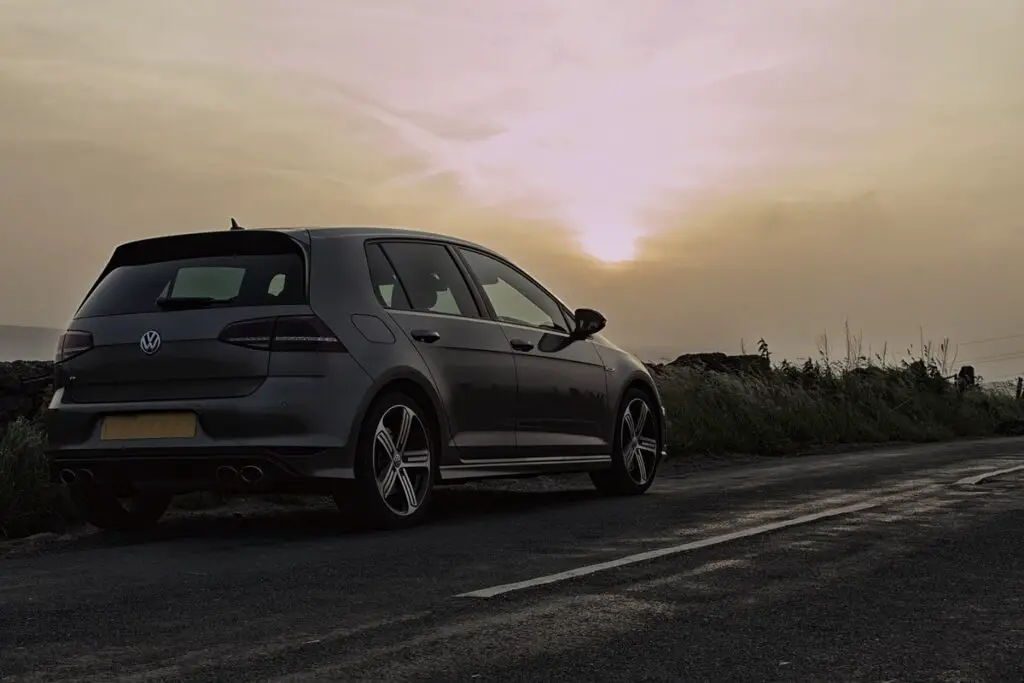
Common Problems with VW Adaptive Cruise Control
While VW’s Adaptive Cruise Control is designed to provide a seamless driving experience, there have been a few reported issues that may impact its performance.
Some of the most common problems with VW’s ACC system include:
Sudden disengagement of the system
Inaccurate speed control, false alerts and warnings, unresponsive controls, unexpected braking, random acceleration.
One of the most frustrating problems reported by VW car owners is the sudden disengagement of the Adaptive Cruise Control system while driving.
This can be a safety concern, especially on highways and busy roads where consistent speed control is crucial. In such cases, the ACC system may turn off without any warning or apparent reason, leaving the driver to manually adjust their speed.
Reasons: This could be due to various reasons, including technical malfunctions or sensor issues. It can be a cause for concern as it disrupts the smooth driving experience that ACC is designed to provide.
Solutions: If you encounter sudden disengagement of the ACC system, it is recommended to get your vehicle checked by a certified mechanic or visit your nearest VW dealership for assistance.
It’s also essential to follow the proper maintenance schedule and keep all sensors clean to avoid this problem.
Another common issue reported by drivers is inaccurate speed control while using Adaptive Cruise Control. This can lead to unexpected acceleration or deceleration, causing discomfort and potentially hazardous situations on the road.
Inaccurate speed control refers to the ACC system not maintaining a steady speed as set by the driver. It may result in sudden changes in velocity, which can be dangerous, especially in heavy traffic conditions.
Reasons: There can be several reasons for inaccurate speed control on VW Adaptive Cruise Control. One of the main culprits could be a malfunctioning sensor, which may not accurately measure the distance from other vehicles on the road.
Additionally, outdated software or calibration issues can also lead to incorrect speed control by the ACC system.
Solutions: To ensure accurate speed control, it is crucial to keep your vehicle’s sensors and cameras clean at all times. Additionally, always follow the manufacturer’s recommended maintenance schedule for your vehicle.
If you notice any issues with the ACC system, have it checked by a professional immediately.
Aside from inaccurate speed control, another common issue with VW Adaptive Cruise Control is false alerts and warnings.
This can happen when the system detects a potential collision or obstacle on the road, causing it to apply brakes abruptly even if there is no real danger.
False alerts and warnings occur when the ACC system mistakenly identifies a potential collision or obstacle on the road, causing it to react as if there is an imminent danger.
Reasons: False alerts and warnings can occur due to a variety of reasons, including environmental factors such as heavy rain or snow that may obstruct the sensors’ view.
Other common causes include objects on the road that resemble other vehicles, low sensor battery, or issues with the system’s software.
Solutions: To address false alerts and warnings, it is essential to regularly clean and maintain the sensors and cameras of your vehicle’s ACC system.
If you encounter this issue frequently, consider getting the system checked by a certified technician for any underlying hardware or software problems.
In some cases, recalibrating the system or updating its software may also help resolve false alerts.
Another common problem reported by VW owners with adaptive cruise control systems is unresponsive controls. This issue occurs when the system fails to respond to driver inputs, such as adjusting the desired speed or distance from other vehicles.
Reasons: There are several potential reasons for unresponsive controls in a VW adaptive cruise control system. One common cause is dirty or damaged sensors, which may prevent the system from accurately detecting and responding to other vehicles on the road.
Additionally, issues with the system’s wiring or connections can also lead to unresponsiveness.
In some cases, software glitches or malfunctions may cause the controls
Solutions: If you are experiencing unresponsive controls with your VW adaptive cruise control, there are several steps you can take to address the problem.
First, try cleaning the sensors and ensuring that they are not obstructed by any debris or damage.
If this does not solve the issue, it may be necessary to have a technician examine the system for any potential hardware or software problems.
In some cases, a system reset or software update may also help to resolve the issue.
It is important to address any problems with your ACC system promptly and seek professional assistance if needed to ensure safe and reliable operation.
Another common issue reported with VW adaptive cruise control is unexpected braking. This can occur when the system incorrectly detects a vehicle in front and applies the brakes, causing a sudden decrease in speed.
Drivers may also experience this when approaching a curve or exit ramp, where the system mistakenly interprets an obstacle as a vehicle and engages the brakes.
Reasons: There are several potential reasons for unexpected braking in a VW ACC system. One possible cause is a dirty or damaged sensor, which may not accurately detect the distance of other vehicles.
Another reason may be an issue with the software, such as outdated mapping data or incorrect settings.
In some cases, certain weather conditions, such as heavy rain or snow, can also affect the accuracy of the system’s sensors and cause unexpected braking.
Solutions: If you are experiencing any issues with your VW adaptive cruise control, there are several steps you can take to address the problem.
First, make sure all sensors and cameras are clean and free of obstructions. You can also try recalibrating the system by following the instructions in your vehicle’s manual or consulting a professional technician.
In some cases, updating the software may also resolve any issues.
If the problem persists, it is important to have your VW ACC system inspected and serviced by a certified technician to ensure safe and accurate operation.
Additionally, staying informed about any recalls or updates from Volkswagen can help prevent potential issues with your system.
Another common problem reported by VW owners with adaptive cruise control is random acceleration.
This occurs when the system suddenly accelerates the vehicle without any input from the driver. This can be a dangerous and unnerving experience for drivers, especially on busy roads or highways.
Reasons: There are several possible reasons for random acceleration with VW adaptive cruise control. One common cause is a dirty or malfunctioning sensor, which can send incorrect signals to the system and result in unintended acceleration.
Another potential reason could be a software glitch or error, which may require updating or recalibrating the system.
In rare cases, there may be a mechanical issue with the vehicle itself that is causing the random acceleration.
Solutions: If you experience random acceleration with your VW adaptive cruise control, there are a few potential solutions to consider.
First, it is always recommended to have your vehicle inspected by a certified Volkswagen technician to identify and address any underlying issues.
This may involve cleaning or replacing the sensor, updating software, or making necessary adjustments to the system.
In some cases, a simple reset of the system may also resolve the issue.
How does VW adaptive cruise control work?
Now that we’ve covered some common problems with VW’s adaptive cruise control system, let’s take a closer look at how it works.
VW adaptive cruise control uses radar sensors and cameras to monitor the distance between your vehicle and other vehicles on the road.
Based on this information, the system can automatically adjust your vehicle’s speed to maintain a safe following distance.
It can also bring the vehicle to a complete stop if necessary, and resume driving when the traffic ahead moves again.
This technology is especially helpful in heavy traffic or on long highway drives, reducing driver fatigue and stress while maintaining safe driving distances.
Can you turn off the adaptive cruise control VW?
Yes, you can easily turn off adaptive cruise control on your VW vehicle.
Simply press the “Off” button on the cruise control system or use the controls on your steering wheel to deactivate it.
You can also adjust the following distance and set a maximum speed limit for the system to operate within.
If you need to temporarily pause the system, such as in heavy traffic or construction zones, you can also use the “Resume” button to resume adaptive cruise control.
You May Also Be Interested In Reading
https://www.vwpartsvortex.com/blog/volkswagen-cruise-control-not-working
https://www.businessinsider.com/volkswagen-cruise-control-accelerates-owners-car-without-warning-report-2023-1
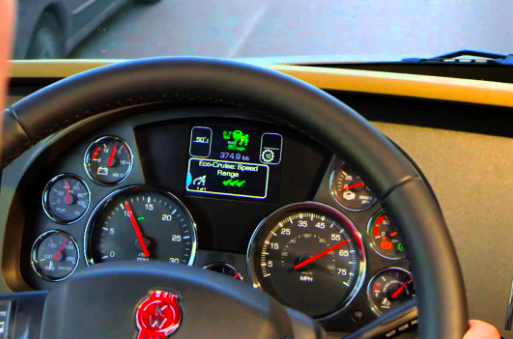
Kenworth W900 Cruise Control Problems
Are you having trouble with the cruise control on your Kenworth W900? Don’t worry – it’s a common issue that can be quickly resolved with the help of experienced mechanics. With their expert advice, you can quickly identify and troubleshoot the Kenworth W900 Cruise Control Problems to get you back on the road.
🚨You may be interested in: Kenworth Electrical Problems
Troubleshooting Kenworth W900 Cruise Control Problems
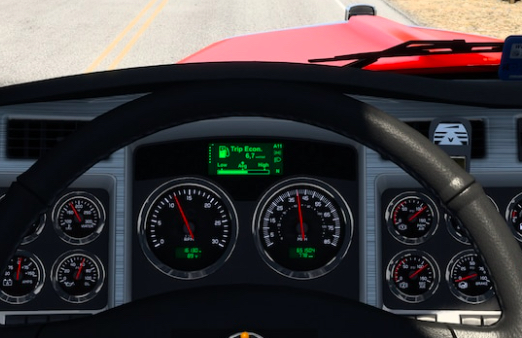
Are you experiencing cruise control issues with your Kenworth W900 truck? Don’t fret – this is a common problem that can be quickly resolved with the help of an experienced mechanic. With their expertise, you can identify the root cause of the issue and take the necessary steps to get your truck back on the road. This article will explore the common Kenworth W900 cruise control problems, their causes, and solutions.
Electrical System
The electrical system of the Kenworth W900 can be a source of cruise control problems. Issues with the system can prevent the cruise control from engaging or cause the cruise control to suddenly disengage. To diagnose the issue, experienced mechanics will first inspect the wiring and connections for any signs of damage or loose connections. In some cases, the wiring or connectors may need to be replaced.
Vacuum System
The vacuum system is another potential cause of cruise control problems in the Kenworth W900. The vacuum system provides the pressure for the cruise control to engage and remain active. If the system is not functioning correctly, the cruise control may be unable to hire or unexpectedly disengage. A qualified mechanic can inspect the system and replace any defective components.
⚡️Another article: Kenworth Def Problems
Throttle Cable
The throttle cable is an essential component of the Kenworth W900’s cruise control system and can be a source of problems. If the line is loose or worn, the cruise control may not engage or unexpectedly disengage. A qualified mechanic can inspect the cable and replace it if necessary.
Control Module
The control module controls the cruise control system on the Kenworth W900. If the module malfunctions, it can prevent the cruise control from engaging or cause it to disengage unexpectedly. It is essential to have the module inspected by a qualified mechanic to diagnose and repair any issues.
The Kenworth W900 can experience cruise control problems due to various issues, including electrical system problems, problems with the vacuum system, a loose or worn throttle cable, or a malfunctioning control module. With the help of experienced mechanics, these issues can be quickly identified and resolved, allowing you to get back on the road with the convenience and comfort of cruise control.
Key Takeaways for Troubleshooting Kenworth W900 Cruise Control Problems
- Problems with the electrical system, vacuum system, throttle cable, or control module commonly cause cruise control issues in the Kenworth W900.
- An experienced mechanic can inspect these components and replace damaged or defective parts.
- Faulty wiring and connectors may need to be replaced.
- A malfunctioning control module can prevent the cruise control from engaging or cause it to disengage unexpectedly.
- Following the necessary steps will ensure your truck is back on the road with the convenience and comfort of cruise control.
Cruise Control Troubleshooting: Achieving a Smooth Ride in Your Kenworth W900
Cruise control is an essential feature in the Kenworth W900, ensuring a smooth and comfortable ride. However, when cruise control issues arise, the ride can become bumpy. Fortunately, experienced mechanics can help diagnose and repair the source of the problem to get your truck back on the road with the convenience and comfort of cruise control.
💥See also: Kenworth Power Steering Problems
Common causes of cruise control problems in the Kenworth W900 include electrical system issues, vacuum system problems, a loose or worn throttle cable, and a malfunctioning control module. By inspecting the wiring and connectors and replacing any damaged or defective parts, your truck can return to the road with cruise control in no time. You can ensure your Kenworth W900 provides a smooth, comfortable, and convenient ride with the proper steps.
Leave a Comment Cancel reply
Save my name, email, and website in this browser for the next time I comment.
Ask an Expert Cancel reply

IMAGES
VIDEO
COMMENTS
Use a vacuum pump to apply vacuum to the dump hose to approximately 15 inches, and then press on the brake pedal. The vacuum should be dumped and the gauge should read 0. If the vacuum is not ...
It can also be caused by issues with the throttle control system or the ABS. In older cruise control systems, it can be caused by a broken vacuum line. Here is a more detailed list of the possible reasons your cruise control is not working: 1. Blown Fuse. All electrical systems in the vehicle are controlled by fuses.
Problems with older cruise control systems. Before electronic injection and electronic throttle bodies, some cars had the cruise control function. In fact, the first cruise controls were introduced in the early 1950s. These electromechanical cruise controls are pretty simple. They have a vacuum actuator connected to the throttle linkage that ...
Diagnosing Cruise Control Problems. To effectively diagnose cruise control problems, begin by utilizing a scanner or traditional methods to pinpoint the underlying issues. Check to see if any fuses related to the cruise control system are blown, as this can often cause malfunctions.
This will cause the cruise control system to turn off until the fuse is replaced. 4) Check Engine Warning Light. If the check engine warning light comes on, it usually means there is a problem with your transmission or engine. Once the engine control unit detects this problem, it may disable your cruise control system in response as a safety ...
Cruise control not working in your vehicle? Today we're going over three main components of the cruise control system - The Cruise Control Main Switch, Cruse...
A problem with the brake switch (or clutch switch), cruise control switch, or VSS can cause issues in any system. More advanced cruise control systems have additional sensing devices (e.g., APP sensors), that can also cause problems. Control Module Issues. Some vehicles rely solely on a dedicated module to govern the cruise control system.
Electrical Wiring Issues: Problems with the electrical wiring connected to your cruise control system can cause intermittent disconnections. Loose connections, damaged wires, or faulty connections can all lead to the cruise control system losing power. To troubleshoot this issue, you can follow these steps:
Problems with the throttle body. Malfunctioning sensors. Blown fuse and electrical issues. Faulty brake pedal switch. Bad mechanical cruise control cable. All of these reasons can make your cruise control ineffective and the worst thing is if it malfunctions while you are using it.
Problems with the computer: The computer, or control module, is the brains of the cruise control system. A problem with the computer or its circuit can affect cruise control operation. In many electronic systems, this not only includes ECM or CCM, but also the body control module (BCM).
Electrical Problems - As most cruise control systems use electrical or electronic components, any diagnosis should include a thorough check of source voltage, wiring harnesses, and connectors. Anything loose or broken could disable the system entirely.
2. Blown Fuse or Relay. Another pretty common reason that cruise control might not be working is because of a blown fuse or relay. These are usually located in the fuse box under the hood. If you think this might be the case, then you can just check the fuse box to see if there's a blown fuse or relay.
The switch is essentially the control surface for the cruise control system. When it has any problems, it can cause issues with the functionality of the cruise control system. Usually a problem with the cruise control switch will produce a few symptoms that can alert the driver of a potential issue that should be serviced. Cruise control light ...
Another symptom of a problem with the cruise control reservoir is a cruise control system that simply cannot maintain speed. If the cruise control vacuum reservoir fails, the cruise control system will be left without its necessary vacuum reserve, and as a result, will not be able to hold the vehicle at the set speed or rate of acceleration. 3.
Electrical problems, such as wiring issues, faulty connectors, or a malfunctioning cruise control module, can disrupt the proper functioning of the cruise control system. Identifying and addressing these common reasons for cruise control failure can help you troubleshoot and resolve any issues you may be experiencing.
Occasionally, you may encounter issues with your cruise control systems. Common problems include cruise control not engaging or disengaging unexpectedly. Possible causes may include a faulty brake light switch, malfunctioning sensors, or issues with the control module. If you experience any problems with your cruise control, it's best to have a ...
Step 2 - Check the under-dash fuse box. If cruise control does not engage after the green light appears, the problem is most likely due to a blown fuse. Open the under-dash fuse box below the instrument panel. Check your owner's manual to determine which fuse number corresponds to the cruise control feature. Fuse numbers vary by model and year.
2. Faulty brake pedal switch. Another possible cause of a cruise control problem is an issue with your brake pedal. This component turns your brake lights off and on, depending on the position of your pedal. When you press on the brake pedal, this disengages the cruise control system. Hence, if there are issues with your brake pedal switch ...
Here's how a broken fuse can affect your cruise control system: 1.1. Circuit Interruption: The cruise control system relies on a network of electrical circuits to communicate between the command center and various components. A blown fuse breaks this circuit, severing the communication link and preventing the system from functioning. 1.2.
Definition and Brief Explanation of Adaptive Cruise Control (ACC) Adaptive Cruise Control, often referred to as ACC, is a sophisticated driver assistance system that has become increasingly prevalent in modern vehicles. Unlike traditional cruise control, which maintains a constant speed set by the driver, ACC is designed to automatically adjust ...
Select "Settings" and then choose "Vehicle Settings.". Scroll down and select "Driver Assist System Setup.". Choose "Adaptive Cruise Control" and then click on "Reset.". Confirm the action by pressing "Yes" when prompted. Exit the menu and test the adaptive cruise control feature to see if the problem has been resolved.
While VW's Adaptive Cruise Control is designed to provide a seamless driving experience, there have been a few reported issues that may impact its performance. Some of the most common problems with VW's ACC system include: Sudden disengagement of the system. Inaccurate speed control. False alerts and warnings.
The electrical system of the Kenworth W900 can be a source of cruise control problems. Issues with the system can prevent the cruise control from engaging or cause the cruise control to suddenly disengage. To diagnose the issue, experienced mechanics will first inspect the wiring and connections for any signs of damage or loose connections.